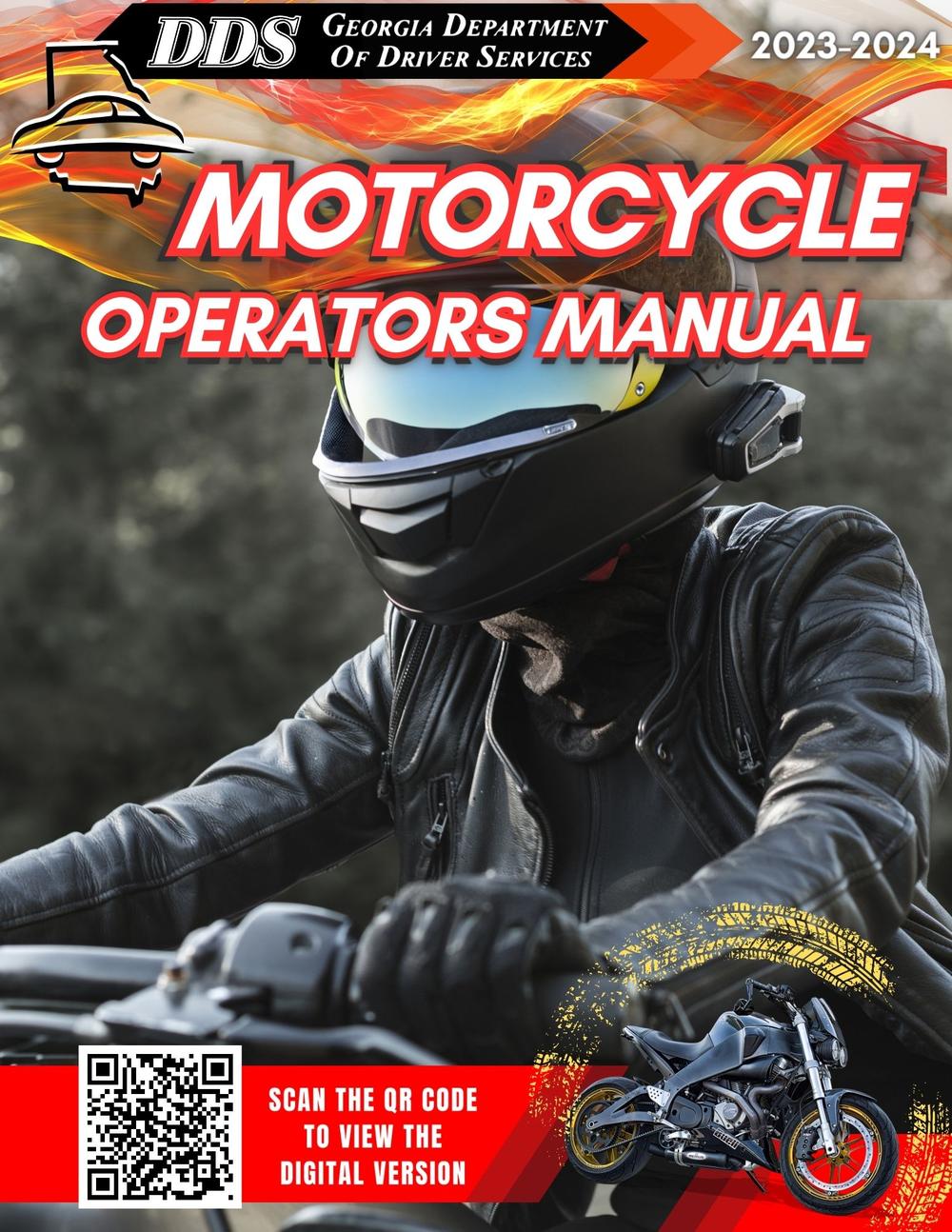
All Locations Closed for New Years Day 2026
All locations are closed Thurs 1 Jan, 2026 for the holiday.
Georgia Department of Driver Services Motorcycle Operators Manual, 2023–2024

DDS Mission & Core Values
Our Mission
To provide secure driver and identity credentials to our customers with excellence and respect.
Our Core Values:
- Trusted Service
- Ethical Actions
- Accountable to All
- Motivated to Excellence
#Reimagining Driver Services in 2023
Title VI Policy Statement
The Georgia Department of Driver Services (DDS) is committed to compliance with Title VI of the Civil Rights Act of 1964 and all related nondiscrimination authorities. DDS assures that no person shall, on the grounds of race, color, national origin, sex, age, disability, low-income, and Limited English Proficiency (LEP), be excluded from participation in, be denied the benefits of, or be otherwise subjected to discrimination under any program or activity. DDS further assures that every effort will be made to ensure nondiscrimination in all programs and activities, whether or not those programs and activities are federally funded. In addition, DDS will take reasonable steps to provide meaningful access to services for persons with Limited English Proficiency. Finally, DDS agrees to abide by the Title VI Program Assurances and to ensure that written agreements with any party for federally funded programs or services will include the applicable Title VI language as provided in the Title VI Program Assurances.
The DDS Title VI Program Coordinator is responsible for oversight of the Title VI Program and ensuring compliance with the requirements provided in 49 Code of Federal Regulations (C.F.R) Part 21 and 49 C.F.R. Part 303. The Title VI Program Coordinator and all Division Directors are authorized to effectively implement the Title VI Program on behalf of the Department.
DDS Online Services
Be certain to take advantage of DDS Online Services and avoid an unnecessary trip to a Customer Service Center.
DDS Online Services enable thousands of Georgia drivers to conduct many transactions via the DDS website and eliminate a visit to a DDS Customer Service Center (CSC). This saves customers valuable time and money. DDS does not charge an additional fee for choosing Internet Services. A $5.00 discount may apply for eligible license types that are renewed on the internet.
For more information visit the DDS website and like DDS on Facebook!
Save Time! Use DDS Online Services at DDS.Georgia.Gov

Save Time long description
Card Services
- Submit Proof of Residency and/or Social Security
- Address Change
- License/ID Renewal or Replacement
- Class D to Class C Upgrade
- CDL Self-Certification Medical Documents
- License Status
- Suspension or Reinstatement Information
Pay Fees
- Super Speeder
- License Reinstatement
- Pending Suspensions
Other Services
- Online For-Hire Endorsement Application
- Skip a Step! (Complete Form Online)
- Driving History (MVR)
- Motorcycle Safety Training Registration
- Make Road Test Appointment
- Reservation Status
This manual is produced by the Governmental Affairs and Communications Division.
The information contained in this publication is intended for motorcycle operators; it does not address all laws, restrictions, requirements and other issues that all highway users must know and observe in order to safely and responsibly operate a motor vehicle on Georgia’s roadways. Motorcycle operators are also required to read and understand the information contained in the Georgia Drivers Manual. This manual is available from all Department of Drivers Services Customer Service Centers and may be viewed at the DDS website.
The information contained in this publication is offered for the benefit of those who have an interest in riding motorcycles. The information has been compiled from publications, interviews and observations of individuals and organizations familiar with the use of motorcycles, accessories, and training. Because there are many differences in product design, riding styles, federal, state and local laws, there may be organizations and individuals who hold differing opinions.
DDS Motorcycle Training

Basic RiderCourse (BRC)
Introduces the exciting world of motorcycling.
Successful graduates earn their Motorcycle License with a 90-day license test waiver!
- Self-paced eCourse & 2-day On-cycle Training
- Motorcycle & helmet provided
- For new & experienced riders
- $250.00: Enrollment fee
- $300.00: Out-of-state fee
Basic RiderCourse 2 (BRC2)
An excellent refresher course for renewing and practicing basic riding skills.
Successful graduates earn their Motorcycle License with a 90-day license test waiver!
- 1-day Classroom & On-cycle Training
- For riders with basic skills or a desire to refresh
- Riders provide their own helmet, protective gear, and motorcycle
- $100.00: Enrollment fee
- $150.00: Out-of-state fee
Advanced RiderCourse (ARC)
Complements a rider’s basic skills and includes a fast paced classroom segment with several interactive activities to improve perception and hazard awareness.
- 1-day Classroom & On-cycle Training
- Riders provide their own helmet, protective gear, and motorcycle
- For experienced riders with a Class M license
- $100.00: Enrollment fee
- $150.00: Out-of-state fee
Real Riding, Real Skills: The Georgia Motorcycle Safety Program

The Georgia Motorcycle Safety Program (GMSP) is a part of the Georgia Department of Driver Services. GMSP’s purpose is to improve the safety of motorcyclists on Georgia’s streets and highways. In addition to offering rider education training, licensing improvement, and public information, GMSP promotes motorist awareness programs, share the road campaigns, and is focused on highway safety issues. GMSP directly operates training sites throughout Georgia.
For information about the Georgia Motorcycle Safety Program visit dds.georgia.gov/motorcycle-safety-program or call (678) 413-8400.
Training Sites
- Albany
- Between
- Brunswick
- Clarkesville
- Columbus
- Dalton
- Hinesville
- Lawrenceville
- Lithonia
- Locust Grove
- Marietta
- Perry
- Thomson
- Valdosta
Check the DDS website for new training sites added after publication.
Register today!
Visit the DDS website & select Regulatory Compliance/Georgia Motorcycle Safety Program or call (678) 413-8400.
Messages
Governor's Message

"I wish you safe passage and encourage you to exercise good judgment, follow driving laws, and prioritize safety for yourself, fellow motorists, and passengers."
Brian P. Kemp
Governor

Commissioner's Message

"Operating a motorcycle is a tremendous responsibility and we want you to be fully prepared to meet the challenges! By wearing the appropriate gear, obeying all traffic laws and never drinking and riding, we can ensure that our highways are safer for riders, drivers and passengers alike.”
Spencer R. Moore
Commissioner
Board of Directors' Message
Board of Directors
- David W. Connell, Chair
- Jeff MarKey, Vice Chair
- Britt Fleck, Secretary
- Tony Guisasola, Member
- Rachel Little, Member
- Christie Moore, Member
- Bob Pierce, Member
- Sheriff Frank Reynolds, Member
- Kat Satterfield, Member
Our Board of Directors would like to remind all customers that driving in Georgia is a privilege that carries many responsibilities. Please be a safe and dependable driver to ensure that this privilege will not be lost. This manual has two main purposes:
- to help you qualify for a Georgia motorcycle license; and
- to help you become a safer rider.
This guide is designed to provide you with the information to obtain and keep this type of license. Other manuals are available for commercial drivers and teens learning to drive.
Section 1: Motorcycle Rider Licensing
This Section Covers
- How to Obtain Your Motorcycle License – 1.1
- Required Motorcycle License Test – 1.2
- Rider Skills Test – 1.3
- Motorcycle Rider Education, Training, and License Test Waivers – 1.4
- Signs, Signals, and Markings – 1.5
Operating a motorcycle can be safe and fun when you act as a responsible rider. It also requires special skills and a heightened sense of awareness about other road users, traffic, and environmental conditions and a personal strategy to manage potential problems.
Studying this manual will not only help you pass your licensing tests, but it will also help prepare you to become a responsible and safe motorcyclist.
Take your time learning how to operate your motorcycle and get plenty of riding experience and training. You’ll need to be fully prepared for handling today’s traffic environment and reducing the potential for a crash.
1.1 – How to Obtain Your Class M Motorcycle License
You may obtain a Class M Motorcycle License if you:
- Are at least 17 years of age.
- Under age 18, a parent, legal guardian or responsible adult to sign the Form for Driver’s License/ID/Permit and complete the Responsible Adult Affidavit.
- Under age 18, a Certificate of School Enrollment (Form DS-1) must be presented.
- Pass required Motorcycle License tests, which include special road signs test, a special road rules test and an actual riding test on a motorcycle. (NOTE: The Motorcycle License test is waived if a 90-day test waiver is submitted for successfully completing the Basic RiderCourse or Basic RiderCourse 2.)
- Pass a vision test. If the vision test was administered and passed during the year in conjunction with another license issuance, the vision test may be waived.
- If the applicant meets the established requirements for a Class M License and also possesses a Class C or combination of other classes of permits, that license must be surrendered and a license containing the Class M will be issued. The applicant will not be given a refund for their remaining period of validity of the other license.
Class MP – Instructional Permit
An Instructional (Learner’s) Permit is issued for the purpose of learning how to operate a motorcycle on public roads or highways. An Instructional Permit is not a Motorcycle License.
All Instructional Permit applicants must pass a vision test and an examination of motorcycle knowledge. A Class M Instructional Permit (MP) is valid for 6 months. It is not mandatory for a Class M License applicant to obtain a Class M Instructional Permit (MP) before taking the Class M examination, although road test reservations are available only to those applicants who hold a Class M Instructional Permit (MP). Requirements for a Class M Instructional Permit (MP) are as follows:
- Must be at least 16 years of age.
- Applicants 16 years of age must comply with Joshua’s Law by successfully completing a DDS certified Georgia Driver Training/Driver Education Course consisting of at least 30 hours of theoretical instruction (classroom or virtual) and 6 hours of practical behind-the-wheel instruction (instructor or parent taught). A list of certified courses can be found online at https://online.dds.ga.gov/ddsgeorgiagov/locations/certified-driver-trai….
- Pass Vision Exam.
- Pass Motorcycle Knowledge Exam.
- If applicant is under 18 years of age, then a parent, legal guardian or responsible adult is required to sign the Form for Driver’s License/ID/Permit and complete the Responsible Adult Affidavit. The participating signatories also have the authority to request revocation of the permit at any time before the minor’s 18th birthday.
- Under age 18, a Certificate of School Enrollment (Form DS-1) must be presented.
MP Restrictions are:
- Motorcycle operation in daylight hours only.
- No passengers allowed.
- No limited access roadways.
- Safety equipment as prescribed by law.
Real ID License Documentation Requirements
DDS has been issuing Real ID compliant licenses and IDs since 2012. These procedures require that you bring additional documentation with you when you visit one of our Customer Service Centers (CSC).
To verify that you have a Real ID card, check the upper right-hand corner of your license/ID for either a Black star or Gold star.
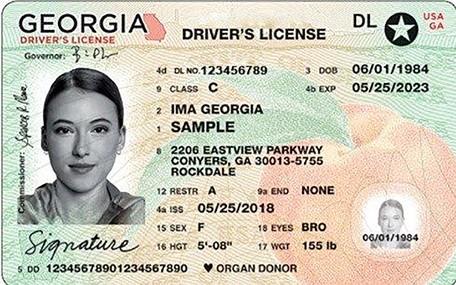

If you are a US Citizen and have a Real ID card, you will NOT need to bring your documents in again unless you are performing a name change, gender change or other services that require identification verification.
If you are new to Georgia or do not have a Real ID license, please visit the DDS website's Real ID Requirements page to identity which documents you will need to bring.
Different Types of Vehicles
When looking at different types of motorcycles or motor-driven cycles, you will see the term “cc” along with a number: 250cc, 500cc, 750cc. The “cc” is an abbreviation for cubic centimeter, the volume of fuel mixed with air that powers motorcycles. Road-legal motorcycles, scooters, and even mopeds can have engines ranging from 50cc to more than 2,000cc. A motorcycle with a higher cc will weigh more and therefore have more power and be able to move more weight at faster speeds.
Motorcycles
Every motor vehicle having a saddle for the use of the rider, is controlled by handlebars, and designed to travel on not more than three wheels in contact with the ground, but excluding a tractor and moped (with engine size not exceeding 50cc), is defined as a motorcycle. Georgia law places all types of motorcycles (including scooters, motorbikes and mini-bikes with engine size 51cc or greater) into one classification. All are considered motor-driven cycles. A Class M License or a Class M Instructional Permit (MP) is required to legally operate a motorcycle or motor-driven cycle in Georgia.
Mopeds
A moped is defined as any motor driven cycle with an engine not exceeding 50cc (3.05 cubic inches). Mopeds are exempt from the provisions relating to the registration and licensing of motor vehicles.
Rules to operate mopeds on Georgia roads and highways:
- Must be at least 15 years of age and possess a valid driver’s license, instructional permit or limited permit.
- Must wear protective headgear (U.S. Department of Transportation (DOT) compliant motorcycle helmet).
- No tag is required.
- Must obey the same traffic laws governing drivers of motor vehicles.
- May not use limited access highways or other roadways where the minimum speed limit is above 35 mph.
1.2 – Required Motorcycle License Tests
Safe riding requires knowledge and skill. Licensing tests are the best measurement of the basic skills necessary to operate safely in traffic. Assessing your own skills is not enough. People often over-estimate their own abilities. It’s even harder for friends and relatives to be totally honest about your skills. Licensing exams are designed to be scored more objectively.
There are two ways to earn a motorcycle license. You can take a Georgia Motorcycle Safety Program Course where you will receive professional training in motorcycle handling (motorcycles are provided) as well as earn a License Test Waiver (if you successfully complete the course).
The License Test Waiver will allow you to bypass the knowledge test and the on-cycle skills test at a DDS Customer Service Center. See the section on the Georgia Motorcycle Safety Program in this manual.
The other method is to apply directly at a DDS Customer Service Center. To earn your license, you must pass a knowledge test and an on-cycle skills test (on your own motorcycle). You must also pass a vision test. If the vision test was administered and passed during the year in conjunction with another license issuance, this vision test may be waived.
Knowledge Test – you will need to take and successfully pass the Knowledge test. Knowledge test questions are based on information, practices and ideas from this manual. They require that you know and understand road rules and safe riding practices. NOTE: This requirement is waived for applicants who have successfully completed a Georgia Motorcycle Safety Program License Test Waiver rider education course.
Rider Skills Test – you will need to take and successfully pass an on-cycle skills test, which consists of a series of exercises designed to demonstrate your basic skills in operating a motorcycle. NOTE: This requirement is waived for applicants who have successfully completed a Georgia Motorcycle Safety Program 90-Day License Test Waiver rider education course.
You must furnish a motorcycle for the test and pass a safety inspection of the motorcycle by the DDS license examiner before the on-cycle skills test is given.
Basic vehicle control and crash-avoidance skills are included to determine your ability to handle normal and hazardous traffic situations.
The on-cycle skills test is designed for single-track vehicles (motorcycles) and multi-track vehicles (motorcycles with sidecars, and three-wheeled vehicles). Motorcycles with sidecars and three-wheeled vehicles maneuver differently than a two-wheeled single-track motorcycle. Vehicles outside of test standards may be required to use a car test route. Please be mindful on-cycle testing cannot be completed in an autocycle (i.e. three-wheel car-like vehicles).
Motorcycle Safety Courses
All riders are also encouraged to attend a rider education course which provides knowledge and hands-on training before receiving a motorcycle operator’s license.
Under the Georgia Motorcycle Safety Program (see section "1.1 How to obtain your class M motorcycle license), you may earn a License Test Waiver for your Class M Motorcycle License in the Basic RiderCourse and Basic RiderCourse 2. A 90-day license test waiver is provided to successful graduates.
Check out the rider education courses at The Georgia Motorcycle Safety Program.
You can also view rider education courses online at the DDS website.
1.3 – The Rider Skills Test
Safe motorcycle riding depends largely on your knowledge and skills. The skills for motorcycling require a lot of practice. If you have just learned to handle a motorcycle and have very little riding experience, then the most important part of learning to ride is still ahead.
You may wish to take a Georgia Motorcycle Safety Program rider education course that offers a License Test Waiver. For more information about locations and schedules, visit the DDS website.
The Rider Skills Test (RST) is used for both two-wheeled (RST-2W) and three-wheeled vehicles (RST-3W). The following pages highlight the testing patterns for both the two-wheel and three-wheel test.
Both tests consist of four riding evaluations that measure your control of the motorcycle and your hazard-response skills. The final two exercises involve speeds of about 15-20 miles per hour.
You will be scored on time/distance standards as well as path violations. The test may be ended early for point accumulation, committing an unsafe act, or failure to understand or follow instructions.
When you report for your test:
- You must have a DOT compliant helmet, eye protection and closed toe footwear.
- For safety, it is suggested that you wear long sleeves, long pants and gloves.
- You must furnish a street-legal motor-driven cycle for the test and pass a safety inspection of the motorcycle by the DDS license examiner before the riding test is given.
PLEASE NOTE: You have the right to cancel the test at any time. Inform the DDS driver examiner that you do not wish to continue the test. The examiner will explain the conditions for rescheduling the test.
The DDS license examiner also has the right to stop the test if you (a) fail to demonstrate basic control skills, (b) accumulate more than the maximum number of penalty points allowed, (c) commit any unsafe act (d) fail to understand or follow directions, or (e) fall from or drop the motorcycle.
Finally, all testing may be suspended due to inclement weather, equipment failure or other circumstances beyond the control of you or the examiner.
Rider Skills Test for Two-Wheels
Evaluation #1: Cone Weave & Normal Stop

Directions:
From the start point ride to the right of the first cone, to the left of the second, and so on.
After passing the last cone, turn left and ride toward the opposite side of the course. Make a smooth, non-skidding stop with your front tire inside the box.
Points will accumulate if you:
- Stall during the exercise
- Put a foot down or hit/skip a cone during the weave
- Fail to stop with your front tire within the borders of the box
Evaluation #2: Turn From a Stop & U-Turn

Directions:
From the start point make a right turn between the boundary lines.
After completing the turn, diagonally cross to the opposite side of the course and make a left U-Turn inside the painted box at the far end of the course. Do not touch the solid (24') line for motorcycles 600cc or more, or the dashed (20') line for motorcycles less than 600cc.
Stop with your front tire inside the box.
Points will accumulate if you:
- Stall during the exercise
- Put a foot down
- Touch or cross a boundary line
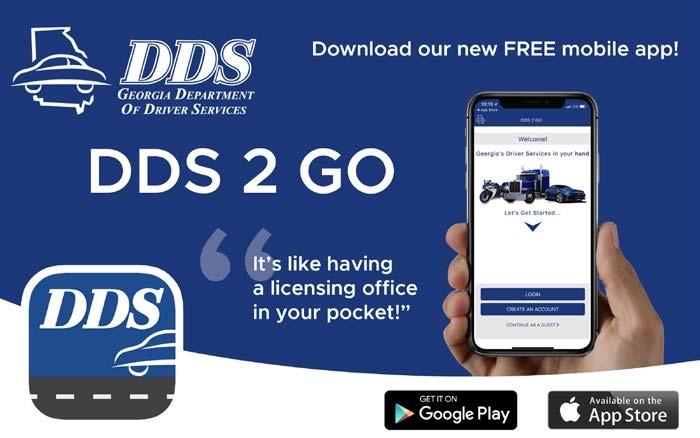
Evaluation #3: Quick Stop

Directions:
From the start point accelerate straight up the path. Stabilize your speed between 12-18 mph by the time you reach the first line. Maintain a steady speed.
When your front tire crosses the second line, stop as fast as you safely can, using both brakes.
This test will be timed in order to determine your speed.
Points will accumulate if you:
- Stall during the exercise
- Fail to stop within the established standards
- Anticipate the stop (braking early) on 2nd attempt
- Fail to obtain the proper speed on 2nd attempt
Evaluation #4: Obstacle Swerve

Directions:
From the start point accelerate straight up the path. Stabilize your speed between 12-18 mph by the time you reach the first line. Maintain a steady speed.
When your front tire passes the second line, swerve to the left or right as directed.
This test will be timed in order to determine your speed.
Points will accumulate if you:
- Stall during the exercise
- Touch or cross the obstacle line or sideline with either tire
- Swerve in the wrong direction
- Anticipate the swerve (swerving before second line) on 2nd attempt
- Fail to obtain the proper speed on 2nd attempt
Once you have successfully passed all of the required tests and met all other licensing requirements you may be issued a Class M Motorcycle License.

Better together.
The MSF (Motorcycle Safety Foundation) is proud to partner with Georgia Department of Driver Services to bring its cutting edge curriculum to the current prospective riders of Georgia.
The best first ride is an MSF RiderCourse℠.
Successful completion of the MSF Basic RiderCourse waives the DDS Motorcycle License test.
Get trained – get licensed.
msf-usa.org
Rider Skills Test for Three-Wheels
Evaluation #1: Left Turn & Normal Stop

Directions:
From the start point ride straight ahead and make a sharp left turn between the boundary lines and the single cone marker.
Then ride toward the opposite end of the course. Make a smooth, non-skidding stop with your front tire inside the box. (Left front tire on vehicles with two front tires).
Points will accumulate if you:
- Stall during the exercise
- Touch or cross a boundary line
- Hit or skip the boundary cone
- Fail to stop with your front tire within the borders of the box
Evaluation #2: Cone Weave & Turn from a Stop

Directions:
From the start point ride to the left of the first cone, to the right of the second and to the left of the third.
After passing the last cone turn right at the end of the course and stop at the Start “T” facing the other side of the course. Then make a right hand turn between the boundary lines and the cone.
Make a smooth, non-skidding stop with your front tire inside the box.
Points will accumulate if you:
- Stall during the exercise
- Touch or cross a boundary line
- Hit or skip the boundary cone
- Hit or skip a cone during the weave
Evaluation #3: Quick Stop

Directions:
From the start point accelerate straight up the path. Stabilize your speed between 12-18 mph by the time you reach the first set of cones. Maintain a steady speed.
When your front tire crosses the second set of cones, stop as fast as you safely can, using both brakes.
This test will be timed in order to determine your speed.
Points will accumulate if you:
- Stall during the exercise
- Fail to stop within the established standards
- Anticipate the stop (braking early) on 2nd attempt
- Fail to obtain the proper speed on 2nd attempt
Evaluation #4: Obstacle Swerve

Directions:
From the start point accelerate straight up the path. Stabilize your speed between 12-18 mph by the time you reach the first set of cones. Maintain a steady speed.
When your front tire passes the second set of cones, swerve to the left or right as directed.
This test will be timed in order to determine your speed.
Points will accumulate if you:
- Stall during the exercise
- Touch or cross the obstacle line or sideline with your tire
- Swerve in the wrong direction
- Anticipate the swerve (swerving before second set of cones) on 2nd attempt
- Fail to obtain the proper speed on 2nd attempt
Once you have successfully passed all of the required tests and met all other licensing requirements you may be issued a Class M Motorcycle License.
1.4 – Motorcycle Rider Education, Training, and License Test Waivers
The Georgia Motorcycle Safety Program (GMSP) offers rider education programs for every level of rider. GMSP also promotes motorist awareness programs, Share the Road campaigns, and focuses on highway safety issues affecting Georgia motorcyclists. The DDS directly operates 14 training sites throughout the state of Georgia. Rider training is popular and potentially life-saving. Without proper training, new riders are more likely to be involved in a crash. Experienced riders also can benefit from additional training to hone their crash-avoidance skills.
Three-Wheel Waiver Program
DDS is pleased to announce that the License Test Waiver Program has been expanded to include the Three Wheel Training Course. Since July 1, 2017, certified Motorcycle Training Schools that offer this training have the ability to issue a 90-day license test waiver upon successful completion of the course. This expansion is being implemented to enhance customer service, expand the Motorcycle Safety Program and to foster consistency.
Rider Education
When you take a Georgia Motorcycle Safety Program Course, you will receive professional training in risk management, motorcycle operation, and skilled riding techniques as well as earning a License Test Waiver (when you successfully complete a license test waiver course).
The License Test Waiver will allow you to bypass the knowledge test and the on-cycle skills test at a DDS Customer Service Center.
You may earn a License Test Waiver for your Motorcycle License in the Basic RiderCourse and Basic RiderCourse 2 License Waiver Course. A 90-day license test waiver is furnished to successful graduates. Courses are low-cost and provide professional training to assist riders in improving their skills in:
- Turning
- Traffic strategies
- Braking
- Evasive techniques
- And more!
Basic RiderCourse
- Self-paced eCourse and On-Cycle Training
- For new & experienced riders
- Motorcycle & helmet provided (at GMSP/DDS Training Centers)
- Earn a Motorcycle License Test Waiver
- $250.00: Enrollment fee (at GMSP/DDS Training Centers; see website for non-resident enrollment fee)
The Basic RiderCourse is the best way to prepare to obtain your motorcycle license. With no experience necessary, it is designed for beginning riders with no previous riding experience. We also recommend this course for riders who have not been on a motorcycle for a while. It combines practice riding on a closed course with classroom discussion.
GMSP provides training motorcycles and helmets at our DDS locations (there are additional riding gear requirements for students). If you own a scooter, you may ride your own scooter, 51-500cc, in the course. Scooter students must call GMSP at 678-413-8400 after registering and inform staff of their intention to use a scooter so we can notify your Coach.
The Basic RiderCourse offers complete and professional training. You will learn how to operate a motorcycle safely, with emphasis on the special skills and mental attitudes necessary for dealing with traffic. GMSP Coaches will start off with straight-line riding, turning, shifting and stopping.
You’ll gradually progress to cornering, swerving and stopping in shorter distances. In the classroom, you’ll learn about the different types of motorcycles, their characteristics, how they operate, and mental processes for riding.
The GMSP Coaches, all experienced motorcyclists, will advise you on what to wear for comfort, visibility and protection. You’ll find out how alcohol and other drugs affect your ability to ride safely. A very important segment of the course will introduce a strategy for riding in traffic, and how to deal with critical situations. The course concludes with a knowledge test and an on-cycle skills evaluation.
Once you successfully complete the course, you will receive a 90-day motorcycle license test waiver. To register, go to the DDS website, or call 678-413-8400.
Basic RiderCourse 2 – License Waiver
If you are an experienced rider without a motorcycle license or have been riding on a permit, earn your license now.
- 1-day Training
- Ride your own bike
- Earn a Motorcycle License Test Waiver with a Basic RiderCourse 2 - License Waiver (BRC2LW) course (some classroom)
- $100.00 Enrollment fee (BRC2LW) (at GMSP/DDS Training Centers). NOTE: The enrollment fee is $150.00 for out-of-state residents.
To register, go to the DDS website, or call 678-413-8400.
Advanced RiderCourse (ARC)
The ARC is a one-day course that complements a rider’s basic skills and helps with personal risk assessment. It focuses on the complex skills of self-assessment, personal risk management, and riding strategies.
The ARC includes a fast-paced classroom segment with several interactive activities to improve perception and hazard awareness. Range exercises enhance both basic skills and crash avoidance skills. Improving braking and cornering finesse is emphasized. The course is beneficial for riders on any type of street motorcycle. For details and a list of facts including required riding gear, visit http://dds.georgia.gov/advanced-riders-course.
To register, go to the DDS website, or call: 678-413-8400.
Scooter Riders
Scooters have become a popular and sensible transportation option. Many people perceive them to be safer and easier to handle than a motorcycle. The reality is that any two-wheel vehicle takes a different skill set to maneuver on the street.
With that in mind, the GMSP welcomes scooter owners to participate in our License Waiver Basic and Basic 2 rider education courses. Scooter owners can now use their machine in a rider education program, and if successful, earn a license test waiver.
Of course, there are a few rules.
- Students use their own scooters. No scooters are provided.
- The scooter must be owned, registered, and insured by the student.
- The scooter must be street-legal and be 500cc or less.
- If the scooter is going to be ridden to and from class, a Class M Instructional Permit (MP) is required. (NOTE: Some classes are held after dark, and permit holders cannot ride after dark.) Students can trailer the scooter to the training location.
- Scooter students must call GMSP at 678-413-8400 after registering and inform staff of their intention to use a scooter, so we can notify your Coach.
Military Waiver
A military member or dependent will not be subject to taking a knowledge test or skills test as if he/she has completed a class offered by the Georgia Motorcycle Safety Program and/or recognized private sites.
Military members and dependents will be eligible to obtain a 90 day license waiver by submitting the following documents to the Motorcycle Safety Program:
- Motorcycle Safety Program Military Waiver application
- copy of a Motorcycle Safety Foundation, Basic RiderCourse, or Basic RiderCourse 2 completion card
- copy of your current Georgia driver’s license
- copy of your active, retired or dependent military I.D. and/or a copy of your DD214.
Once the documentation has been verified, a 90 day license waiver will be updated to his/her driving record. After receiving the waiver, the military member/dependent must visit their local DDS Customer Service Center within 90 days to obtain their Class M license. A military member or dependent that is not currently in the State of Georgia can go to the DDS website for information on renewing a license by mail.
1.5 – Signs, Signals and Road Markings
Georgia law requires that all drivers, including motorcyclists, obey official highway signs and traffic control signals unless otherwise directed by a police officer or emergency worker.
Road Signs
Shapes of Signs
The State of Georgia uses seven basic shapes of signs to convey traffic control instructions. Drivers should know signs by their shapes and colors so that they may recognize them from a distance and begin reacting.
Octagon signs

An Octagon (eight-sided shape) always means stop. When you come to it, you must make a complete stop at a marked stop line. If there is no stop line, stop before the crosswalk on your side of the intersection. If there is no crosswalk, stop at a point from which you can best see oncoming traffic. You must not start again until all pedestrians have finished crossing on the side of the roadway you are traveling on, and you have yielded the right-of-way to closely approaching traffic.
Triangle signs

Triangle signs mean yield. You must slow down to a speed that is reasonable for existing conditions and stop if necessary. If you must stop, do so at a marked stop line, if it exists. After slowing or stopping, you must yield the right-of-way to other vehicles in the intersection or approaching closely on another roadway or auxiliary road leading into a major highway.
Round signs

Round signs mean you are approaching a railroad crossing. This sign is posted a few hundred feet in front of the tracks and alerts you to slow down, look, listen and prepare to stop. Listen carefully for an approaching train. If the train is approaching, stop! Do not try to calculate whether you can “make it” across the track. Never try to beat a train through the intersection. Passing is prohibited at all railroad crossings.
Diamond signs

Diamond shaped signs warn of existing or possible hazards on roadways or adjacent areas. They are yellow with black words indicating the potential hazard, or black symbols visually describing the potential hazard.
Pentagon signs
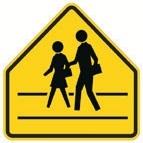
Pentagon shaped signs mean you are approaching a school zone and/or school crossing. When used, they will be erected not less than 150 feet nor more than 700 feet in advance of the school grounds or school crossing. (Warning signs can sometimes be fluorescent green in color.)
Horizontal rectangle signs

Horizontal Rectangle signs are generally used as guide signs. They show locations, directions, or other special information.
Vertical rectangle signs

Vertical Rectangle signs are generally used for regulatory signs, which tell you what you must do. You must obey them in the same manner as traffic laws.
Regulatory Signs
Regulatory signs tell drivers what they may or may not do. Drivers, including bicyclists, must obey them in the same manner as traffic laws. Remember, a red circle with a red slash from upper left to lower right means “No.” The picture within the circle shows what is prohibited.
Do not enter sign
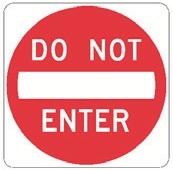
This marks a one-way road. If you are facing this sign traffic is coming toward you. You must not continue down the road.
Wrong way sign

Motorist is approaching a one-way highway or ramp.
One way sign

Motorist may travel only in the direction of the arrow.
Keep right sign

Traffic is required to keep to the right of medians or obstructions.
No U turn sign

Motorist cannot turn around to go in the opposite direction at this intersection.
No right turn sign

Motorist cannot make a right turn at this intersection.
Speed limit 55 sign

55 miles per hour is the maximum speed limit permitted in this area.
Reduced speed ahead sign

Motorist is approaching an area where a reduced speed limit has been established.
Slower traffic keep right sign
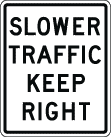
When two or more traveling lanes are available in the direction you are traveling, slower traffic should travel in the right (outside) lane(s).
No right turn on red after stop sign

A right turn on red is prohibited, even after coming to a complete stop.
School speed limit sign

Motorist is approaching a school zone. A reduced speed limit is in effect when the yellow lights are flashing.
No bicycles sign

Bicycles are prohibited from entering this roadway.
No trucks sign

Trucks are prohibited from entering this roadway.
Warning Signs
Warning signs are usually yellow with black markings. (Warning signs can also be fluorescent green with black markings.) They alert you to conditions that are immediately ahead. There may be road hazards, changes in traffic direction or some other potentially hazardous situation that requires action on your part.
Sharp right turn then sharp left turn sign

Sharp turn to the right and then sharp turn to the left.
Sharp right turn sign

Sharp turn to the right.
Winding road sign
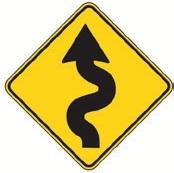
Winding road ahead.
Right curve sign

Curve to the right.
Side road enters ahead sign

Side road enters highway ahead.
Side road enters at an angle sign

Side road enters highway ahead at an angle.
Narrow bridge sign

The bridge ahead allows room for only two lanes of traffic. Approach with caution.
Soft shoulder sign

Shoulder of the road is soft. Drive on the shoulder only in emergencies.
Two way traffic sign
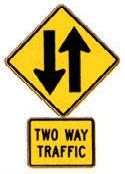
Warning that you are leaving a separated one-way highway and will soon be driving on a two-way highway.
Hill sign
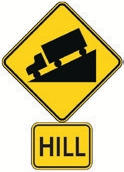
Steep hill ahead. Slow down and be ready to shift to lower gear to control speed and protect brakes from damage.
Road crossing ahead sign

Another road crosses the highway ahead.
Dip sign

There is a dip in the road ahead. Slow down!
Divided highway sign

Divided highway begins. Prepare to change lanes or shift lane position.
Low clearance sign

Approaching a low underpass. Do not enter if your vehicle or cargo exceeds the maximum height indicated on the sign.
Signal ahead sign

Presence of traffic signals at intersection ahead. Slow down!
Road ends sign

The road you are traveling on ends straight ahead. Slow down and prepare to yield or stop before turning right or left.
Bump sign

There is a bump in the road ahead. Slow down!
Divided highway ends sign

Divided highway ends. Prepare to change lanes or shift lane position.
Merge sign

Traffic merging from the right. Prepare to allow traffic to safely merge.
Stop ahead sign

There is a stop sign ahead. Begin to slow down.
Yield ahead sign

There is a yield sign ahead. Slow down and prepare to stop if necessary.
Slippery when wet sign

Roadway is slippery when wet. Remember, the first half-hour of rain is most hazardous.
No passing zone sign
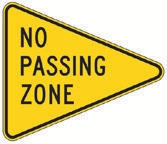
This sign is on the left side of the highway and marks the beginning of a no passing zone. Any passing maneuver must be completed before reaching this sign.
Pedestrian and animal crossing signs
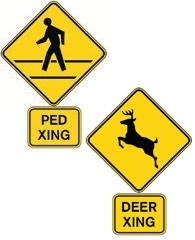
These signs alert drivers in advance of areas where animals, people, and vehicles may be crossing.
Lanes reduced sign

Number of lanes reduced ahead.
Watch for pedestrians in the crosswalk sign

Drivers must stop and stay stopped when pedestrians are in the crosswalk.
Construction and Maintenance Warning Signs
Road construction and Flagman signs

Warning signs for construction and maintenance projects are used to alert you to dangers ahead and give you enough time in which to adjust your speed accordingly. These signs are orange with black markings.
Road closed sign

Service Signs
While traveling along Georgia’s highways, the following blue and white signs will give directions to service facilities.

Camping, hospital and picnic area signs

Guide Signs
Guide signs may indicate what road you are on, and how to get to your destination. Many guide signs are rectangular, but some have other shapes. There are several different kinds of guide signs — route markers, information, destination, distance, and location signs. These signs may be accompanied by a “To” sign or an arrow, indicating the highway, facility, or location that can be reached by following the signs. Here are some examples:
Exit 44 sign

Numbered interstate and highway signs

The numbers on these signs designate specific exits, interstates or highways.
Junction sign

Intersection of U.S. Route 47 & Ga. Highway 38. These roads are going to cross or meet the highway you are traveling on.
Bike route sign

This sign marks an officially designated bicycle route. Be cautious of bicyclists while traveling on this road.
Milepost marker

Milepost markers are placed each mile along the edge of the roadway from one end of the state to the other. Zero always starts at the south or west border where a route begins.
Caution sign

Caution - a vehicle displaying this emblem is a slow moving vehicle. A slow-moving vehicle is defined as any vehicle moving less than 25 miles per hour. They are required by law to display this emblem.
Parking sign

This sign means there is a public parking area in the direction of the arrow.
Railroad crossing sign

The cross-buck is placed at all railroad crossings. Yield to any approaching trains. Slow down, look and listen before crossing. A sign below the cross-buck indicates the number of tracks. A complete stop is required when a red light is flashing.
Traffic Signals and Signs
Traffic signals are placed at intersections to control the orderly movement of traffic and to prevent crashes. Drivers (including bicyclists) and pedestrians must obey these signals except when an officer is directing traffic. If a traffic signal is not functioning at all at an intersection, all drivers must treat the intersection as if a stop sign is posted for all directions. If a traffic signal is malfunctioning and flashing, drivers must proceed based on the color of the flashing signal they are facing: if the driver is facing a yellow flashing signal, the driver may proceed with caution; if the driver is facing a red flashing signal, the driver must stop and wait until it is safe to proceed.
Red light
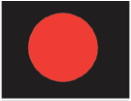
A red light means you must make a complete stop before entering the crosswalk or intersection and wait until the light turns to green before proceeding.
Yellow light
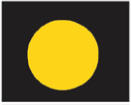
A yellow light warns that the light is changing from green to red. Slow down and prepare to stop.
Green light

A green light means you may proceed if it is safe to do so after stopping for pedestrians and yielding to vehicles within the intersection.
Green up arrow

A green arrow means you may proceed carefully only in the direction the arrow is pointing after stopping for pedestrians and yielding to vehicles within the intersection. In this case you may go straight ahead only.
Green left arrow

A green arrow, in this case, means you may turn in the direction of the arrow after stopping for pedestrians and yielding to vehicles within the intersection.
Yellow right arrow
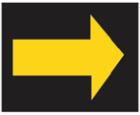
A yellow arrow may appear after a green arrow and warns you to clear the intersection.
Flashing red light

A red flashing light means you must stop completely (treat as you would a stop sign). Proceed with caution only after yielding the right-of-way to pedestrians and to other vehicles at the intersection.
Flashing yellow light

A yellow flashing light means you must slow down and exercise caution before proceeding through the intersection.
Flashing yellow arrow

A flashing yellow arrow means you may turn left after yielding to oncoming traffic and pedestrians (oncoming traffic still has the green light).
Lane Control Signals
Some roadways are designed to accommodate different traffic demands during the day through the use of a reversible lane system. Appropriate travel lanes on a roadway utilizing a reversible lane system are indicated as follows:
No travel allowed signal

No travel allowed in this lane in the direction you are going.
Clear the lane or left turn permitted signal

“Steady” — clear the lane “Flashing” — left turn permitted
Travel in lane signal

Travel in lane.
Overhead Lane Signs
Left turn only sign

Left turn only.
Straight or left turn only sign

Straight or left turn only.
Right turn only sign

Right turn only.
Pedestrian Signals
Walk signal

Leave the curb to cross the street.
Orange Don't Walk signal

Do not leave curb.
Red Don't Walk signal

Flashing — do not leave curb, but complete walking across the street if already started.
Pedestrian safety guide sign
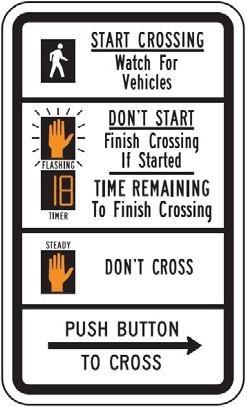
HAWK Signal
“HAWK’ stands for High-Intensity Activated Crosswalk. This signal is also known as a Pedestrian Hybrid Beacon (PHB), and it is designed to help pedestrians safely cross busy streets. Pedestrians push a button to activate the overhead beacon and stop road traffic. When WALK appears on the Pedestrian signal, pedestrians can cross the street.
Dark

The HAWK remains DARK for traffic unless a pedestrian activates the push-button.
Flashing

When a pedestrian presses the button, the signal is activated. Approaching drivers will see a FLASHING YELLOW signal for a few seconds.
Solid Yellow

The flashing yellow is followed by a SOLID YELLOW signal, indicating drivers should reduce speed and be prepared to stop.
Solid Red

The solid yellow is followed by double SOLID RED signals, requiring drivers to stop.
Flashing Red

The double solid red signals are followed by alternating FLASHING RED signals. This requires drivers to come to a full STOP, and proceed when pedestrians have cleared the crosswalk. The signal will then go dark until activated again by a pedestrian.
Pavement Markings
Pavement markings, like highway signs, are used to warn and direct drivers to regulate traffic.
Stop Lines

Stop lines are white lines painted across the pavement at intersections indicating the point beyond which your vehicle should not cross if you are stopping for a traffic control device. In urban areas the line is usually located about four feet before the crosswalk. Drivers must come to a complete stop at the stop line, when present, not at the actual stop sign or traffic signal.
Crosswalk Lines
These white lines are painted across, or partially across the pavement. Sometimes they will be painted in a ladder pattern. When pedestrians are in the crosswalks, they have the right-of-way over motor vehicles. Crosswalks are sometimes in the middle of a block in residential areas, and in some cases, a pedestrian crossing signal is located at the white line.
Railroad Crossings

When a road is crossed by a railroad crossing, the pavement is usually marked with a large X and two R’s. At railroad crossings, a yellow line is always placed on the right side of the center line to prevent passing. The crossing is sometimes equipped with control arms and/or emergency lights, to warn drivers of approaching trains. The driver of the vehicle must stop if warning signals indicate a train is approaching
Center Lines

These are used to separate traffic moving in opposite directions on paved roadways. Broken yellow lines are used when there are only two lanes.
No Passing Lines
Single Lines
These single, solid yellow lines on two-lane roads indicate zones where passing is prohibited. They will be located on the right of the broken yellow line when they apply to the lane in which you are traveling. In some instances, both yellow lines will be solid, indicating it is not safe for passing in either direction.
Double White Lines
These are double white line (dashed or solid) pavement markings on roadways that indicate where vehicles can or cannot cross to access the adjacent lane. When the double white lines are dashed, vehicles are allowed to cross over to the adjacent lane. When the double white lines are solid, lane changes are prohibited.
Edge Lines

These are the solid white lines along the side of the pavement. They serve as safety guides, especially at night when it is difficult to see the edge of the road. A yellow edge line may be used on the left side to warn of narrow or raised medians.
Lane Lines
These are the white dashes that mark the individual lanes of travel on streets and highways having more than one lane for traffic moving in the same direction.
When there are four or more lanes with traffic moving in opposite directions, two solid yellow lines mark the center of the roadway. You may cross these lines only to make a left turn into or from an alley, private road, driveway, or another street. When traveling on a multi-lane road, stay in the right lane except to pass other vehicles traveling in the same direction.
Express Lanes
Express Lanes offer motorists the option to pay a toll to bypass congestion in certain areas on the interstate. All vehicles with no more than two axles or up to six wheels can use Express Lanes if they have a registered Peach Pass. When the vehicle travels through the Express Lane, the toll amount will automatically be deducted from the pre-established account. There are currently two sets of Express Lanes in Georgia.
The I-85 Express Lanes are HOT Lanes along I-85 North in Gwinnett County. They are open 24-hours per day. On the I-85 Express Lanes, registered transit, three or more person carpools, motorcycles, emergency vehicles, and Alternative Fuel Vehicles (AFV) with the proper AFV license plate are allowed to use the lanes toll-free.
The I-75 South Metro Express Lanes are new, reversible lanes along 1-75 South in Henry and Clayton counties. Reversible lanes change directions during the day to provide additional travel options during peak travel periods. When the travel direction is being reversed, signs will show the lanes are closed. On the I-75 South Metro Express Lanes, all vehicles, including motorcycles and electric vehicles, are required to pay a toll. Public transit buses, registered vanpools and emergency response vehicles may use the lanes toll-free if they have a Peach Pass.
Express lanes entrance sign
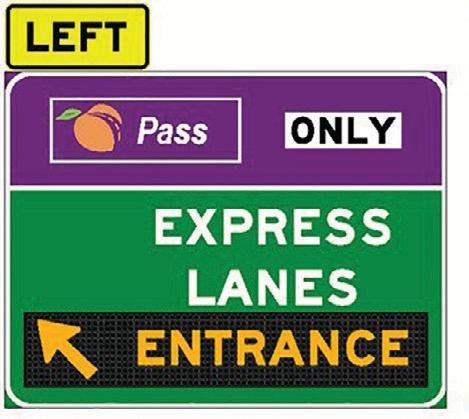
Express lanes closed sign

Turn Lanes

This lane, bordered by solid yellow and/or broken yellow lines, is in the center of streets and highways to make left turns. A motorist desiring to turn left should proceed to the turn lane just prior to making a left turn. Georgia law prohibits the use of this lane for any purpose other than making a left turn. You may enter this lane no more than 300 feet from the location of the left turn.
When a turning lane is provided for vehicles traveling in both directions, you should use extreme caution before entering the turning lane to make a left turn. There may be a vehicle traveling in the opposite direction also entering the turning lane to make a left turn. This is especially problematic in congested areas.
Bicycle Lanes
These are solid white lines typically located between the farthest right traffic lane and the curb or edge of the roadway. If there is a right-turn-only lane present, the bicycle lane will be located to the left of the right-turn-only lane in order to safely accommodate bicycles traveling straight through the intersection. Bicycle lanes may also be marked with painted symbols of a bicycle. Drivers of motor vehicles are prohibited from driving or parking in the bicycle lane, except to cross over it to make a turn. When crossing over a bicycle lane to make a turn, motorists must yield to bicyclists that are present.
Roundabouts
Roundabouts are sometimes used at intersections instead of stop signs. The purpose of a roundabout is to allow the intersection to handle heavier traffic flow without the need for a signal or a four-way stop. When entering a roundabout, traffic laws concerning right-of-way still apply. You must yield to other traffic that is already in the roundabout. You will always enter a roundabout to the right, and continue circling to the right until you have reached the roadway onto which you want to turn. When reaching the desired road, you will always turn right.
Traffic Striping

These markings, created by diagonal yellow lines, are on streets and highways indicating that the road is narrowing or there is an obstruction on the roadway. The area is similar to a triangle with solid yellow diagonal lines within the outside lines. Always keep to the right of these markings.

Section 2: Being in Shape to Ride
This Section Covers
- Alcohol, Other Drugs and Riding – 2.1
- Health – 2.2
- Emotions – 2.3
- Georgia’s Impaired Driving Laws and Penalties – 2.4
Riding a motorcycle demands your full attention. Responsible riders pay attention to the riding environment, identify potential hazards, look for escape routes and make good decisions.
2.1 – Alcohol, Other Drugs and Riding
Alcohol is a major contributor to motorcycle crashes, particularly fatal crashes. According to 2017 NHTSA statistics, 42% of motorcycle riders who died in single-vehicle crashes in 2015 were alcohol-impaired. Riding “under the influence” of alcohol or other drugs poses mental, physical and legal hazards for every rider.
By becoming knowledgeable about the effects of alcohol and other drugs, you will see that riding and alcohol/drugs don’t mix.
Effects of Alcohol and other Impairing Drugs
Alcohol and other drugs impair your:
- Judgment – Alcohol and other impairing drugs affect those areas of your brain that control judgment. You may not be able to make good decisions about the traffic conditions or how to protect yourself.
- Vision – Alcohol and certain types of drugs can blur your vision, slow your ability to focus and cause double vision.
- Reaction Time – Alcohol and other impairing drugs slow your ability to process information and impact your ability to react quickly to a situation.
How Alcohol Works

Unlike other beverages, alcohol is absorbed directly through the walls of the stomach and the small intestine, goes into the bloodstream, and travels throughout the body and to the brain. Alcohol is absorbed quickly and can be measured within 30 to 70 minutes after a person has had a drink.
A typical drink equals about half an ounce of alcohol. This is the approximate amount of alcohol found in:
- one shot of distilled spirits, or
- one 5-ounce glass of wine, or
- one 12-ounce beer.
What Affects My Blood Alcohol Concentration (BAC)?
BAC refers to the amount of alcohol contained in a person’s blood. In all states, an adult with a BAC of 0.08% or above is considered intoxicated. However, impairment begins with the first drink. Even under .08, you can be impaired and convicted for riding impaired. How fast a person’s BAC rises varies with a number of factors:
- The number of drinks. The more you drink, the higher the BAC.
- How fast you drink. When alcohol is consumed quickly, you will reach a higher BAC than when it is consumed over a longer period of time.
- Your gender. Women generally have less water and more body fat per pound of body weight than men. Alcohol does not go into fat cells as easily as other cells, so more alcohol remains in the blood of women.
- Your weight. The more you weigh, the more water is present in your body. This water dilutes the alcohol and lowers the BAC.
- Food in your stomach. Absorption will be slowed if you’ve had something to eat.
Don’t Drink or Don’t Ride
The safest and most responsible choice is to not drink and ride, because once you start, your judgment is affected and your ability to say “no” gets weaker.
If you plan on drinking, leave your motorcycle at home and find other transportation so you won’t be tempted to ride impaired. Or, call ahead to where you plan on drinking and ask if there is a secure place for you to store your motorcycle overnight so you can find an alternative way home – such as a taxi or designated driver.
There are no shortcuts to sobering up fast. None of the “remedies” you may have heard about – cold showers, hot coffee, or physical exercise – will make you sober faster. The only proven remedy to sobering up is time. Remember – your body can process about one drink an hour.
Other Impairing Drugs and Riding
All drugs may affect your ability to ride safely. This is true of many prescription, over-the-counter, and illegal drugs. If you are not sure if it is safe to take a drug and ride, ask your doctor or pharmacist about any side effects.
Never drink alcohol while you are taking other drugs. These drugs could multiply the effects of alcohol or have additional effects of their own. These effects not only reduce your ability to operate your motorcycle, but could cause serious health problems, even death.
2.2 – Health
There are many health conditions that can affect your riding, even little problems. Check with your doctor if a health condition could interfere with you operating a motorcycle.
2.3 – Emotions
Emotions can interfere with your ability to think, create mental distractions, increase risk-taking, create a lack of attention, and interrupt the ability to process information. You may not be able to give all your attention to operating a motorcycle if you are overly worried, excited, afraid, angry or depressed.
2.4 – Georgia’s Impaired Driving Laws and Penalties (OCGA §40-6-391)
First Offense
- Possible jail time up to one year, but not less than 24 hours
- Fine of $300 minimum, up to $1,000
- License suspension of up to one year
- 40 hours of community service, minimum mandatory
- Mandatory DUI Alcohol/Drug Risk Reduction Program at offender’s expense
- Mandatory 12 months probation
- Possible Clinical Evaluation at offender’s expense
- $210 license reinstatement fee
Second Offense within Five Years of First Offense
- Minimum mandatory 72 hours in jail, possible 90 days to one year
- Fine of $600 minimum, up to $1,000
- License suspension of 18 months
- Minimum 30 days community service
- Mandatory 12 months probation
- Mandatory DUI Alcohol/Drug Risk Reduction Program at offender’s expense
- $210 set license reinstatement fee
- A mandatory clinical evaluation at offender’s expense
Third Offense within Five Years of Second Offense
- Minimum mandatory 15 days jail time
- Fine of $1,000 minimum, up to $5,000
- License revocation for five years
- Minimum mandatory 30 days community service
- Violator’s name, photo, and address published in local newspaper at violator’s expense
- Declared as habitual violator, the license plate for his/her vehicle will be seized by the court and forwarded to the Georgia Department of Revenue
- Face a mandatory clinical evaluation at offender’s expense, and, if indicated, completion of substance abuse treatment program at the offender’s expense
- $410 set license reinstatement fee
Open Container Law
The law defines “open alcoholic beverage container” as any bottle, can, or other receptacle that contains any amount of alcoholic beverage and: (1) is open or has a broken seal; or (2) the contents of which are partially removed.
The law prohibits anyone from consuming any alcoholic beverage, or possessing any open alcoholic beverage container in the passenger area of any motor vehicle which is on the roadway or shoulder of any public highway. Only a person who consumes an alcoholic beverage or possesses an open alcoholic beverage container will be charged with an open container violation; however, a driver who is alone in a motor vehicle shall be deemed to be in possession of any open alcoholic beverage container. Anyone who violates this law is subject to a fine not to exceed $200.
This provision does not apply to any passenger in the passenger area of a motor vehicle designed, maintained, or used primarily for the transportation of persons for compensation or in the living quarters of a motor home or house trailer.
All Offenses of Georgia Impaired Driving Laws
The court shall order a person convicted of impaired driving to have an ignition interlock device attached to his/her vehicle for second and subsequent offenses within five (5) years, unless the court exempts the person due to financial hardship. This is required for any vehicle that is operated by the offender for a period of twelve (12) months.
License plates are also seized anytime a violator is convicted of a second or subsequent DUI within five (5) years.
Minors: In addition to court-imposed penalties, drivers between the ages of 15-21 who are convicted of impaired driving must delay obtaining their graduated license for 12 months. The BAC level for DUI for persons under 21 has been established at .02, while the level for adults is .08.
Test Your Knowledge
- If you have only one drink before riding:
- You cannot be arrested for drinking and riding.
- Your riding skills will not be affected.
- It can affect your ability to operate a motorcycle.
- What percent BAC is considered legally intoxicated for adults:
- 0.02%
- 0.04%
- 0.08%
Answers
- C – see the section "What Affects My Blood Alcohol Concentration?"
- C – see the section "What Affects My Blood Alcohol Concentration?"
Proper Hand Signals
Double file

Single file

Obstacle on road—left
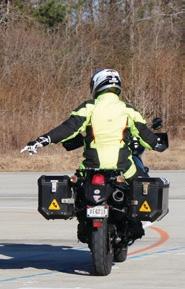
Obstacle on road—right

Pull over

Right turn

Left turn

Slow down

Speed up

Stopping

Section 3: Before You Ride
This Section Covers
- Selecting and Wearing Protective Gear – 3.1
- Getting to Know Your Motorcycle – 3.2
- Motorcycle Controls – 3.3
A responsible rider makes a point to:
- Wear protective riding gear.
- Be familiar with the motorcycle.
- Inspect the motorcycle.
- Be free of impairments (alcohol and drug-free).
3.1 – Selecting and Wearing Protective Gear
Anytime you ride a motorcycle you should wear:
- A helmet compliant with the U.S. Department of Transportation (DOT).
- Face and eye protection.
- Motorcycle protective riding gear (gloves, long pants, jacket, sturdy footwear).
Helmet Use
Crash data shows that head injuries account for a majority of serious and fatal injuries to motorcyclists. Research also shows that riders wearing helmets have fewer and less severe head injuries in a crash.
Here are some facts to consider:
- Georgia requires a DOT compliant helmet.
- Helmets make your riding experience more enjoyable.
- Helmets protect you from the elements (wind, bugs, debris, etc.).
- A DOT compliant helmet does not restrict vision or mask important sounds.
- Crashes are unpredictable and may happen at any time, even on short rides or within minutes of starting the ride.
- Regardless of speed, a helmet will reduce the severity of head injuries.
Helmet Selection

Protection should be the first consideration when buying your motorcycle helmet. There are three primary types of helmets: full face, three-quarter, and half. A full face helmet gives the most protection since it covers all of the head and face. This design has a flip-up face shield that protects the eyes. A three-quarter helmet affords riders good head protection and is constructed with the same basic components, but doesn’t offer the face and chin protection of full-face helmets. If you wear a three-quarter helmet, you should use an approved snap-on face shield or goggles. Half helmets provide the least amount of protection.

Whichever style you choose, make sure that the helmet:
- is DOT compliant. A DOT compliant helmet has a label attached to the helmet that states the manufacturer’s name and/or brand, model, and says DOT, FMVSS No. 218, CERTIFIED.
- has no obvious defects such as cracks, loose padding or frayed straps.
- fastens securely.
Helmet Fit
A helmet should fit comfortably, but snugly. A helmet that is too loose can lift in the wind or come off your head in a fall. One that is too tight can create sore areas or cause headaches. When choosing a helmet, try on several brands and sizes to get an idea of fit and comfort.
Here are a few tips for the best fit:
- Cheek pads should touch your cheeks without pressing uncomfortably.
- There should be no gaps between your temples and brow pads.
- If the helmet has a neck roll, it should not push the helmet away from the back of your neck.
- On full face helmets, press on the chin piece. The helmet or face shield should not touch your nose or chin.
Whatever helmet you decide on, keep it securely fastened on your head when you ride. Otherwise, if you are involved in a crash, it’s likely to come off your head before it gets a chance to protect you.
Face and Eye Protection
Eye protection is required in Georgia. Without face protection, an object could hit you in the eye, face, or mouth. A full face helmet provides the maximum face and eye protection while riding and in the event of a crash. A plastic shatter-resistant face shield can help protect your eyes and face from wind, dust, dirt, rain, insects, and pebbles thrown up from cars ahead. These distractions can be painful and can take your full attention from the road. Whatever happens, keep your eyes on the road and your hands on the handlebars.
Face shields come in a variety of designs to fit most any helmet. Make sure that the face shield you choose is designed for your helmet and does not interfere with eyeglasses or sunglasses.
To be effective, eye or face shield protection must:
- Be free of scratches.
- Be resistant to penetration.
- Give a clear view to either side.
- Fasten securely, so it does not blow off.
- Permit air to pass through, to reduce fogging.
- Permit enough room for eyeglasses or sunglasses, if needed.
Windshields will not protect your eyes from the wind and debris; neither will eyeglasses or sunglasses. A windshield is not a substitute for a face shield. Glasses will not keep your eyes from watering, and they might blow off when you turn your head while riding. Goggles protect your eyes, though they won’t protect the rest of your face like a face shield does. Goggles can also reduce peripheral vision. Tinted eye protection or shields should not be worn at night or any other time when little light is available.
Hearing Protection
Long-term exposure to wind noise can cause irreversible hearing damage. Properly worn hearing protection can reduce wind noise and make your ride more enjoyable, while still allowing you to hear important sounds like car horns and sirens. You can choose from a variety of styles, from disposable foam plugs to reusable custom-molded devices.
Protective Riding Gear
Riding gear designed for motorcycle riders provides protection in the event of a crash, as well as from heat, cold, rain, debris, and hot or moving parts of the motorcycle. Sturdy synthetic or leather materials provide the best protection. Wearing brightly colored clothing with reflective material will make you more visible to other roadway users.
- Jackets and pants should cover arms and legs completely and be made of durable material. Jeans do not provide adequate protection. Wear a jacket even in warm weather to prevent dehydration. Many motorcycle riding jackets are designed to protect without getting you overheated, even on summer days.
- Protective footwear provides protection for the feet, ankles, and lower parts of the legs. Leather boots are best. They should be high and sturdy enough to cover your ankles and give them support. Soles should be made of durable slip resistant material. Sandals, sneakers, and similar footwear should not be used since they provide little protection and may interfere with controls. Keep heels short so they do not catch on rough surfaces. Tuck laces in so they won’t catch on your motorcycle.
- Gloves allow a better grip and help protect your hands. Your gloves should be full-fingered and made of leather or similar durable material.
- Rain suits designed for motorcycle riding resist tearing apart or ballooning up at high speeds. You will be much more comfortable and alert than a rider who is wet and cold. One or two piece styles are available. A rain suit with reflective strips or high visibility orange or yellow colors are good choices.
Whatever the weather conditions, always wear protective gear that will keep you comfortable, enabling you to concentrate on your riding.
3.2 – Getting to Know Your Motorcycle
You should get to know your motorcycle. Learning how things work and what parts need the most attention could reduce your chances of being in a crash and extend the life of your motorcycle. To make sure that your motorcycle will not let you down:
- Handlebar height may not exceed twenty five inches (25”) above operator seat height.
- All motorcycles must have a functioning exhaust system which includes a muffler and tailpipe(s).
- Passenger footrests must be fitted if carrying a passenger.
- Headlight and taillight must be illuminated at all times.
- Read the owner’s manual first and get to know it.
- Be familiar with the motorcycle controls.
- Turn signals are required.
- Adjust mirrors for best rearward view.
- Conduct a pre-ride check of the motorcycle before every ride.
- Keep it serviced and maintained.
- Make sure your motorcycle fits you. Your feet should reach the ground while you are seated on the motorcycle.
3.3 – Motorcycle Controls

It is important to read your motorcycle owner’s manual to learn where your motorcycle controls are and how to operate them. You should be able to operate them while riding without having to look for them.
Test Your Knowledge
- What should be the first consideration when buying your motorcycle helmet:
- Appearance
- Protection
- Price
- A plastic shatter-resistant face shield:
- Is not necessary if you have a windshield.
- Only protects your eyes.
- Helps protect your whole face.
Answers
- B – see the section "Helmet Selection"
- C – see the section "Face and Eye Protection"
Section 4: Vehicle Control Skills
This Section Covers
- Getting Started – 4.1
- Riding in a Straight Line – 4.2
- Shifting Gears – 4.3
- Stopping – 4.4
- Turning – 4.5
The following section offers basic riding information on getting started, shifting gears, stopping, straight-line riding and turning. These basic skills are important to learn before moving onto more complex skills.
4.1 – Getting Started
Pre-trip Inspection - “TCLOCS
(TCLOCS is a Service Mark of MSF)
T = Tires and Wheels
- Air pressure
- Tread
- Cracks, dents, loose spokes
- Bearings
- Brakes
C = Controls
- Levers
- Switches
- Cables
- Hoses
- Throttle
L = Lights and Electrics
- Working condition
O = Oil and Other Fluids
(Coolant, hydraulic fluid, fuel)
- Levels
- Leaks
C = Chassis
- Suspension
- Drive components (chain, belt, or driveshaft)
S = Stands
- Side stand
- Center stand
Mounting the Motorcycle
To mount the motorcycle, stand on the left side of the motorcycle. Keep your eyes up toward the horizon. Grasp both handgrips, squeeze the front brake to keep the motorcycle from rolling, and swing your right leg over the seat. Sit and straighten the bike; raise the side stand with your foot.
Starting the Engine
- Turn the fuel valve (if equipped) and ignition switch ON.
- Shift to NEUTRAL. Do not rely on the indicator light. Rock the motorcycle back and forth without squeezing the clutch lever. If the motorcycle rolls freely, it’s in neutral.
- Turn the engine cut-off switch to ON.
- Turn the choke ON for cold starts. Many motorcycles require squeezing the clutch before the starter will operate. This is also a good precaution against accidentally starting the bike in gear and reduces the load on the starter motor.
- Press the starter button. Avoid using the throttle; the motorcycle should start without it. Many motorcycles have a safety mechanism that cuts power to the motor if the bike is placed in gear with the side stand down; so if you haven’t brought the side stand up, do it now. If the motor doesn’t start in the first 5 to 8 seconds, stop and repeat these steps.
Stopping the Engine, Dismounting and Securing the Motorcycle
- Turn the engine cut-off switch to OFF. Turn the ignition OFF. Turn the fuel valve OFF if your motorcycle has one. Make sure all lights are off.
- To dismount, put the side stand down. Lean the motorcycle onto the side stand. While looking up and grasping both handgrips squeeze the front brake and swing your right leg over. Turn the handlebar fully toward the side stand for stability.
- After dismounting engage the fork lock or other security device, and then remove ignition key.
4.2 – Riding in a Straight Line
Riding Posture
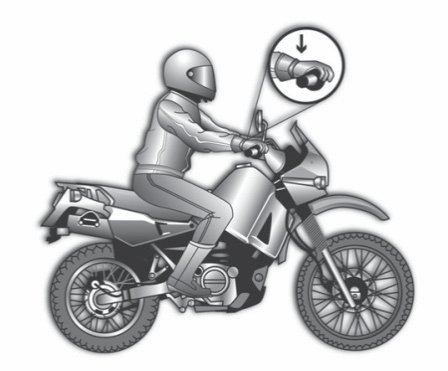
To properly control a motorcycle:
- Posture – Keep your back straight and head and eyes up. Sit so you can use your arms to steer the motorcycle rather than to hold yourself up.
- Hands – Hold the handgrips firmly. Start with your right wrist flat. This will help you to control the throttle.
- Knees – Keep your knees close to the gas tank when the motorcycle is moving.
- Feet – Keep your feet on the footrests when the motorcycle is moving and avoid pointing your toes down. Keep your feet near the controls so you can easily and quickly use them.
Handgrip Position

Friction Zone

Since most motorcycles have a manual transmission, you will need to use the “friction zone” to start the motorcycle moving and to prevent stalling. The friction zone is the point on the clutch where the engine’s power begins to transmit to the rear wheel. As you reach the friction zone, roll on the throttle and the motorcycle will start moving forward. Do not fully release the clutch lever until your motorcycle is moving and stable.
4.3 – Shifting Gears
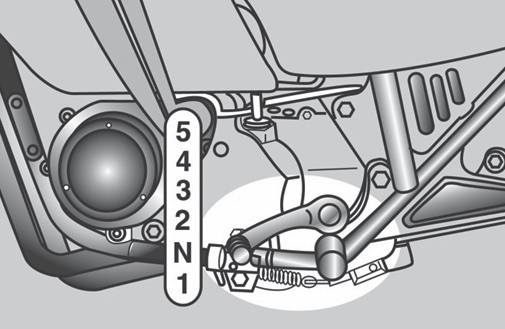
There is more to shifting gears than simply getting the motorcycle to pick up speed smoothly. Learning to use the gears when downshifting, turning, or starting on hills is important for safe motorcycle operation.
To upshift to a higher gear:
- Roll off or close the throttle as you squeeze in the clutch lever.
- Lift the shift lever. Use firm pressure. Release the shift lever after each shift is completed.
- Ease the clutch out as you roll on the throttle.
To downshift to a lower gear:
- Roll off or close the throttle as you squeeze in the clutch lever.
- Press down firmly (but don’t stomp) on the shift lever. Release the shift lever after completing the downshift.
- Ease the clutch out smoothly to avoid skidding the rear tire.
Starting on an Incline
Here are some important tips to remember when starting on a hill:
- Use the front brake to hold the motorcycle while you start the engine and shift into first gear.
- Change to the foot brake to hold the motorcycle while you operate the throttle with your right hand.
- Open the throttle a little bit for more power.
- Release the clutch gradually.
- Release the foot brake when the engine begins to slow down. This means the clutch is beginning to transmit power.
- Continue to release the clutch gradually. If you release it too quickly, the front wheel may come off the ground, the engine may stop, or both.
- Continue to open the throttle gradually, as needed.
It is more difficult to start the motorcycle moving on an upgrade than on flat ground. There is always the danger of rolling backwards into a vehicle behind you.
4.4 – Stopping

Your motorcycle has brakes on the front and rear wheels. Always use both brakes, every time you slow or stop. The front brake can provide 70% or more of your total stopping power, therefore, use of the front brake is required for effective speed reduction. Using both front and rear brakes shortens stopping distance.
To stop your motorcycle, squeeze the front brake and press down on the rear brake gradually until stopped. Grabbing at the front brake or jamming down on the rear can cause the brakes to lock, resulting in control problems.
Normal Stopping in a Curve
If you need to stop while leaned over in a curve, apply smooth gradual pressure to both brakes as you start reducing your lean angle. The more you reduce the lean, the more traction you will have to stop. You can apply more brake pressure as your motorcycle straightens up.
4.5 – Turning
New riders must be aware of the difficulty of negotiating turns and curves. Riders often try to take curves or turns too fast. Reduce speed before entering the turn and maintain this speed. These four steps will help you learn the skills for turning:
- Slow – Reduce your speed before the turn. This can be done by rolling off the throttle as needed and, if necessary, applying both brakes.
- Look – Look through the turn to where you want to go. Turn just your head, not your shoulders, and keep your eyes level with the horizon.
- Press – Press forward on the handgrip in the direction of the turn. Press left handgrip forward– lean left – go left. Press right handgrip forward – lean right – go right. The higher the speed in a turn, the greater the lean angle.
- Roll – Roll on the throttle to maintain steady speed or gradually accelerate through the turn. This will help keep the motorcycle stable.
Steps for Turning
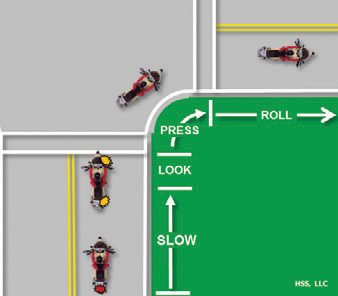
Turning Techniques
Normal Turns

In normal turns, the rider and the motorcycle should lean together at the same angle.
Tight Turns

In slow tight turns, counterbalance by leaning the motorcycle only and keeping your body straight.
Test Your Knowledge
- When stopping, you should:
- Use both brakes.
- Use the front brake only.
- Use the rear brake only.
- When turning, you should:
- Turn your head and shoulders to look through turns.
- Turn just your head, not your shoulders to look through turns.
- Keep your knees away from the gas tank.
Answers
- A – see the section "Stopping"
- B – see the section "Turning"
Section 5: Street Strategies
This Section Covers
- Risk Awareness/Acceptance – 5.1
- Risk Management – 5.2
- Intersections – 5.3
- Space Management – 5.4
- Escape Routes – 5.5
- Increasing Conspicuity – 5.6
- Speed Management – 5.7
Safe riding is more of a skill of the eyes and mind than of the hands and feet. You need to develop a set of street riding strategies that allows you to gather critical information to make good decisions and avoid problems.
5.1 – Risk Awareness/Acceptance
Almost all activities people engage in have some level of risk. Operating a motorcycle requires your constant and full attention to reduce risk. Consider the following steps to manage risk and be a responsible rider:
Rider Responsibilities
Accept the responsibilities associated with operating a motorcycle:
- You must have a motorcycle license or permit.
- You will be expected to follow the laws and rules of the road.
- You must share the road with other users (i.e. pedestrians, bicyclists, large vehicles, etc.)
- Ride alcohol and drug-free.
- Always wear protective gear.
Risk Awareness
Riding a motorcycle involves some risks not encountered when driving other types of vehicles. Some of these risks include:
- Vulnerability – motorcycles provide less protection in a crash and do not have the stability of cars. This is why you should always wear protective gear.
- Visibility – motorcycles are not as visible as other types of vehicles because of their size. Other motorists may not be looking for motorcycles in traffic. This places you at risk.
Risk Acceptance
Once you become aware of the risks associated with motorcycling, it is time to accept those risks. Choosing to accept the challenges of being a responsible motorcyclist means to think about the consequences of your riding behavior in traffic. It also means accepting personal responsibility for the results of your decisions and actions, as well as developing good skills and judgment.

5.2 – Risk Management
To manage risk, you must be aware of the potential risks and then have a plan to reduce the risks.
SEE℠
SM – SEE is a Service Mark of MSF. Used with permission.
SEE is a powerful, but simple, strategy - Search, Evaluate, Execute. It is the strategy to help you understand what is going on in traffic and to be constantly planning and implementing a course of action. Let’s examine each of these steps.
Search

Searching aggressively as far ahead as possible, to the sides and behind to identify potential hazards and escape routes, may help to avoid a crash. When searching ahead, you should search for:
- Road and surface characteristics – potholes, bridge gratings, railroad tracks, debris, curves, slippery surfaces, etc. may influence your riding strategy.
- Traffic control markings and devices – look for traffic signals and signs to help you know what to expect ahead.
- Other roadway users – vehicles in front of you traveling in the same direction, those behind you, vehicles traveling in the opposite direction, those entering and leaving the roadway and turning. Pedestrians also can cross your path of travel or reduce your escape route options.
While it’s most important to keep track of what’s happening ahead, you can’t afford to ignore situations behind. Knowing what’s going on behind will help you make a safe decision about how to handle trouble ahead. To search behind:
- Check your mirrors – frequent mirror checks should be part of your normal searching routine. Make a special point of using your mirrors when you are stopped at an intersection, before you change lanes, and before you slow down.
- Use head checks – checking your mirrors is not enough. Motorcycles have “blind spots” like cars. Before you change lanes, turn your head, and look to the side for other vehicles. Only by knowing what is happening all around you, are you fully prepared to deal with it.
Don’t forget to check the instruments and gauges regularly, too.
Evaluate

Once you have identified the hazard(s), the next step is to quickly determine if they could affect you. Ask yourself, “what if?”
Think about how hazards can interact to create risk for you. Anticipate potential problems and have a plan to reduce or eliminate the risk. Think about your time and space requirements in order to maintain a margin of safety. You must leave yourself time and space to react if a dangerous situation occurs.
Execute

Carry out your decision. What are you going to do and how are you going to do it?
To create more space and minimize harm from any hazard:
- Adjust your position and/or direction.
- Adjust your speed by accelerating, stopping or slowing.
- Communicate your presence and intentions with turn signals, lights and/or horn.
Apply the SEE strategy to give yourself time and space. It works anywhere and can help to minimize your risk and the risk of others.
5.3 – Intersections

The greatest potential for conflict between you and other traffic is at intersections. Cars that turn left in front of you are the biggest dangers. Your use of SEE at intersections is critical.
Increase your chances of being seen at intersections. Ride with your headlight on in a lane position that provides the best view of oncoming traffic. Provide a space cushion around the motorcycle that permits you to take evasive action.
When approaching an intersection where a vehicle is preparing to cross your path:
- Slow down.
- Select a lane position to increase your visibility to that driver.
- Cover the controls to reduce the time you need to react.
- As you enter the intersection, move away from the vehicle.
- Do not make radical movements, as drivers might think you are preparing to turn.
- Be prepared to take action.
Traffic-Activated Sensor Lights

Traffic-activated sensor lights can be troublesome for motorcyclists since the sensor may not detect your presence.
To ensure the best chance of being detected, stop where the sensors are located. They are usually visible in the road surface.
5.4 – Space Management
It is extremely important to maintain an adequate “cushion of space” between vehicles.
Increasing the distance between vehicles will provide you with:
- Time to react.
- Space to maneuver.
A responsible rider recognizes that time and space is the best protection against potential hazards.
Lane Positions

In some ways the size of the motorcycle can work to your advantage. Each traffic lane gives a motorcycle three paths of travel, as indicated in the illustration.
Your lane position should:
- Increase your ability to see and be seen.
- Avoid others’ blind spots.
- Avoid surface hazards.
- Protect your lane from other drivers.
- Communicate your intentions.
- Avoid wind blast from other vehicles.
- Provide an escape route.
In general, there is no single best position for you to be seen and to maintain a space cushion around the motorcycle. No portion of the lane need be avoided – including the center, if weather and roadway conditions permit.
Position yourself in the portion of the lane where you are most likely to be seen and you can maintain a space cushion around you. Move from one side of the lane to another to increase your distance from other vehicles. A responsible rider changes position as traffic situations change. Ride in path 2 or 3 if vehicles or other potential hazards are on your left. Remain in path 1 or 2 if hazards are on your right. If vehicles are present on both sides of you, the center of the lane, path 2, is usually your best option.
The oily strip in the center portion that collects drippings from cars is usually no more than 2 feet wide. Unless the road is wet, the average center strip permits adequate traction to ride on safely. You can operate to the left or right of the oily strip and still be within the center portion of the traffic lane. Avoid riding on big buildups of oil and grease usually found at busy intersections or toll booths.
Following Another Vehicle

Motorcycles need as much distance to stop as cars. It is recommended that new motorcycle operators try to maintain a minimum four-second following distance behind the vehicle ahead. This allows you space to stop, swerve, and keep a reasonable space cushion.
A larger cushion of space is needed if your motorcycle will take longer than normal to stop. For example, if you are riding 40 mph or more, if the pavement is slippery, if you cannot see through the vehicle ahead, or if traffic is heavy and someone may squeeze in front of you, open up a five second or more following distance.
Keep well behind the vehicle ahead even when you are stopped. This will make it easier to get out of the way if someone behind you is not slowing down. It will also give you a cushion of space if the vehicle ahead starts to back up for some reason.
To gauge your following distance:
- Pick out a marker, such as a pavement marking, sign, pole or other stationary point, on or near the road ahead.
- When the rear bumper of the vehicle ahead passes the marker, count off the seconds: “one-thousand-one, one-thousand-two, one-thousand-three, one-thousand-four.”
- If you reach the marker before you reach “four,” you are following too closely.
- Reduce speed and then count again at another stationary point to check the new following interval. Repeat until you are following no closer than “four-seconds.”
Being Followed
Speeding up to lose someone following too closely only ends up with someone tailgating you at a higher speed.
A better way to handle tailgaters is to get them in front of you. When someone is following too closely, change lanes and let them pass. If you can’t do this, slow down and open up extra space ahead of you to allow room for both you and the tailgater to stop. This will also encourage them to pass. If they don’t pass, you will have given yourself and the tailgater more time and space to react in case an emergency does develop ahead.
Lane Sharing
Vehicles and motorcycles need a full lane to operate safely. Do not share lanes with other vehicles. Lane sharing can leave you vulnerable to the unexpected and reduces your space cushion. You should ride in a staggered formation when following other motorcycles. Position the motorcycle in the center of the travel lane, if weather and roadway conditions permit, to discourage motorists from attempting to squeeze by the motorcycle. Do not ride between rows of stopped or moving motor vehicles. This can be dangerous.
Prevent Lane Sharing – Ride in Center of Lane

Prevent Lane Sharing – Ride in Staggered Formation

Merging Vehicles
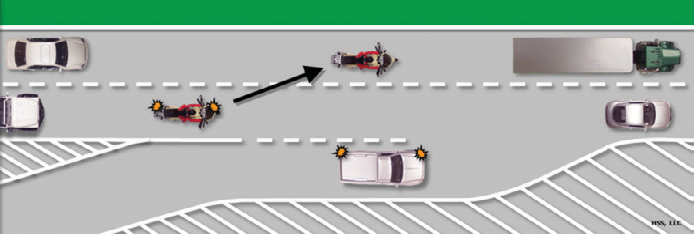
Do not assume that drivers merging on an entrance ramp will see you. Minimize the potential for danger by giving them plenty of room. Change lanes if one is open. If there is no room for a lane change, adjust speed to open up space for the merging driver.
Vehicles Alongside
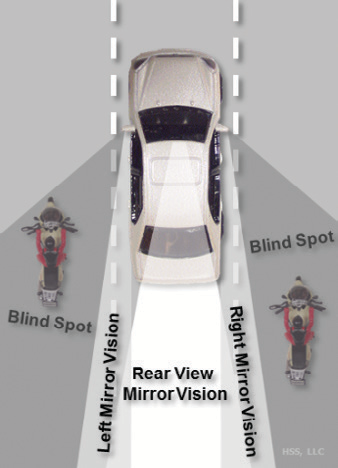
Avoid riding in the blind spot of a vehicle. Responsible riders recognize that vehicles traveling in the adjacent lane may unexpectedly change direction forcing the rider into a potentially dangerous situation. Vehicles in the next lane also block your escape if you come upon a hazard in your own lane. Adjust your speed until a proper and adequate space cushion has been established between vehicles.
5.5 – Escape Routes
An escape route is an alternate path of travel that you can take if a hazard develops in your path. No matter what the conditions, always use SEE and plan an escape route. In the illustration on the top of the next page, the first box shows a rider who has three escape routes open, if an alternate path is needed. The second box shows a rider who has not planned an escape path. The rider has nowhere to go if an alternate path of travel is needed, which leaves the rider vulnerable to potential hazards.
Maintain an Escape Route
Three Escape Routes Open
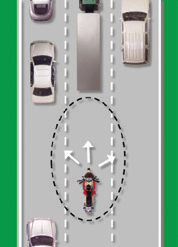
- Three Escape Routes open:
- Bumper-to-bumper traffic
- Cushion preserved
- Three escape routes open
All Escape Routes Closed

- Truck ahead stops
- Vehicle behind still approaching
- All escape routes closed
5.6 – Increasing Conspicuity
In crashes with motorcyclists, drivers often say that they never saw the motorcycle. From ahead or behind, a motorcycle’s outline is much smaller than a car’s. Also, it’s hard to see something you are not looking for, and most drivers are not looking for motorcycles. More likely, they are looking through the narrow, two-wheeled silhouette in search of cars that may pose a problem to them.
Even if a driver does see you coming, you aren’t necessarily safe. Motorcycles may appear farther away, and seem to be traveling slower than they actually are. It is common for drivers to pull out in front of motorcyclists, thinking they have plenty of time. Too often, they are wrong. However, you can do many things to make it easier for others to recognize you and your cycle.
Clothing

Most crashes occur in broad daylight. Wear bright colored clothing to increase your chances of being seen. Remember, your body is half of the visible surface area of the rider-motorcycle unit.
Reflective, bright colored clothing is best. Bright orange, red, yellow or green jackets or vests are your best bets for being seen. Brightly colored helmets can also help others see you. Reflective material on a vest and on the sides of the helmet will help drivers coming from the side spot you. Reflective material can also be a big help for drivers coming toward you or from behind.
Headlight
The best way to help others see your motorcycle is to keep the headlight on – at all times.
(NOTE: New motorcycles sold in the USA since 1978 automatically have the headlights on when running.) Studies show that, during the day, a motorcycle with its light on is twice as likely to be noticed. Also, use your low beams in fog or at night when traffic approaches.
Signals

The signals on a motorcycle are the same as those on a car. They tell others what you plan to do. Use them anytime you plan to change lanes or turn. Use them even when you think no one else is around. Due to a rider’s added vulnerability, signals are even more important. They make you easier to spot.
When you enter a freeway, drivers approaching from behind are more likely to see your signal blinking and make room for you.
Once you turn, make sure your signal is off or a driver may pull directly into your path, thinking you plan to turn again.
Brake Light
Your motorcycle’s brake light is usually not as noticeable as the brake lights on a car – particularly when your taillight is on. (The taillight goes on with the headlight.) If the situation will permit, help others notice you by flashing your brake light before you slow down.
It is especially important to flash your brake light before:
- You slow when others might not expect (for example, turning off a high-speed highway.)
- You slow where others may not expect it (for example, in the middle of a block or at an alley.)
If you are being followed closely, it’s a good idea to flash your brake light before you slow down. The tailgater may be watching you and not see something ahead that will make you slow down. This will hopefully discourage them from tailgating and warn them of hazards ahead they may not see.
Horn
Be ready to use your horn to get someone’s attention quickly. Keep in mind that a motorcycle’s horn isn’t as loud as a car’s, therefore, use it, but don’t rely on it. Other strategies may be appropriate along with the horn.
5.7 – Speed Management
Handling Dangerous Surfaces
- Slippery surfaces
- Railroad tracks
- Grooves and gratings
Slippery Surfaces
On slippery surfaces, you should use added caution. Motorcycles handle better when ridden on surfaces with good traction. Maintaining balance and cycle control are difficult on slippery surfaces.
To reduce your risk, you can take certain preventative measures:
- Reduce Speed – Slow down before you get to a slippery surface to lessen your chances of skidding and increase your following distance. Your motorcycle needs more distance to stop. And, it is particularly important to reduce speed before entering wet curves.
- Avoid Sudden Moves – Any sudden changes in speed or direction can cause a skid. Be as smooth as possible when you speed up, shift gears, turn or brake.
- Use Both Brakes – The front brake is still effective, even on a slippery surface. Squeeze the brake lever gradually to avoid locking the front wheel. Remember, apply gentle pressure on the rear brake.

Surfaces that provide poor traction include:
- Wet surfaces – Particularly, just after it starts to rain and before surface oil washes to the side of the road. When it starts to rain, ride in the tire tracks left by cars and avoid pooled water and highway ruts. Often, the left tire track will be the best position, depending on traffic and other road conditions as well.
- Ice or snow covered surfaces – Snow melts faster on some sections of a road than on others. Patches of ice can occur in low or shaded areas and on bridges and overpasses. It is recommended you avoid snow and ice covered surfaces.
- Shiny surfaces – Metal covers, steel plates, bridge gratings, train tracks, lane markings, leaves and wood can be very treacherous when wet.
- Dirt and gravel – On curves and ramps leading to and from highways, dirt and gravel can collect along the sides of the road. Choose a lane position that minimizes the risk of injury.
- Oil spots – Watch for these when you put your foot down to stop or park. You may slip and fall. Securing the proper footing will help you from losing your balance or falling.
Railroad Tracks, Trolley Tracks and Pavement Seams
Crossing Tracks

Usually, it is safer to ride straight within your lane to cross tracks. Turning to take tracks at a 90 degree angle can be more dangerous – your path may carry you into another lane of traffic.
Crossing Parallel Tracks

For track and road seams that run parallel to your course, move far enough away from tracks, ruts, or pavement seams to cross at an angle of at least 45. Then, make a quick, sharp turn. Edging across could catch your tires and throw you off balance.
Railroad Crossings

- Trains and motorcycles don’t mix. Never race a train to the crossing — even if you tie, you lose.
- The train you see is closer and faster moving than you think. If you see a train approaching, wait for it to go by before you proceed across the tracks.
- Be aware that trains cannot stop quickly. Even if the locomotive engineer sees you, a freight train moving at 55 miles per hour can take a mile or more to stop once the emergency brakes are applied. That’s 18 football fields!
- Never drive around lowered gates — it’s illegal and deadly. If you suspect a signal is malfunctioning, call the 1-800 number posted on or near the crossing signal or your local law enforcement agency.
- Do not get trapped on the tracks; proceed through a highway-rail grade crossing only if you are sure you can completely clear the crossing without stopping. Remember, the train is three feet wider than the tracks on both sides.
- If your vehicle ever stalls on a track with a train coming, dismount immediately and move quickly away from the tracks in the direction from which the train is coming. If you run in the same direction the train is traveling, when the train hits your vehicle you could be injured by flying debris. Call your local law enforcement agency for assistance.
- At a multiple track crossing waiting for a train to pass, watch out for a second train on the other tracks, approaching from either direction.
- When you need to cross train tracks, go to a designated crossing, look both ways, and cross the tracks quickly, without stopping. Remember, it isn’t safe to stop closer than 15 feet from a rail.
- ALWAYS EXPECT A TRAIN! Freight trains do not follow set schedules.
- Trains may be prohibited from sounding their horn at crossings. Check the railroad track visually in both directions before crossing.
Railroad crossing sign

Report a stalled vehicle sign

Grooves and Gratings
Riding over rain grooves or bridge gratings may cause your motorcycle to weave. Maintain a steady speed and ride straight across. Crossing at an angle forces riders to zigzag to stay in the lane.
Gate Crossings

Test Your Knowledge
- The greatest potential for conflict between you and other traffic is:
- On the expressway.
- At intersections.
- When riding in a group.
- Usually a good way to handle tailgaters is to:
- Change lanes and let them pass or slow down to allow for more space ahead.
- Speed up to put distance between you and the tailgater.
- Ignore them.
- When it starts to rain it is usually best to:
- Ride in the center of the lane.
- Ride on the right side of the lane.
- Ride in the tire tracks left by cars.
- The best way to help others see your motorcycle is to:
- Keep the headlight on.
- Use eye contact.
- Honk your horn.
Answers
- B – see the section " Intersections"
- A – see the section "Being Followed"
- C – see the section "Slippery Surfaces"
- A – see the section "Increasing Conspicuity"
Section 6: Roadway Management
This Section Covers
- Crash Avoidance – 6.1
- Cornering – 6.2
- Sharing the Road with Commercial Vehicles – 6.3
On the road, situations change constantly. As a responsible rider, you know how important it is to be in full control of the motorcycle. A responsible rider knows that good road management starts with knowledge and practice of SEE.
6.1 – Crash Avoidance
No matter how careful you are, there will be times when you find yourself in a difficult spot. Your chances of avoiding a crash and possible injury will depend on your ability to react quickly and properly. Two critical crash avoidance skills you will need to learn and practice are stopping quickly and swerving.
Stopping Quickly
Stopping a motorcycle quickly and safely is a skill that requires a lot of practice.
This is accomplished by applying controlled pressure to both the front and rear brakes at the same time without locking either wheel.
To do this:
- Squeeze the front brake lever and apply pressure to the rear brake pedal at the same time. Do not apply maximum pressure to the front brake lever and rear brake pedal all at once. Gradually increase pressure to the front brake lever as weight is transferred forward to the front tire.
- Keep your knees against the tank and your eyes up, looking well ahead. Good riding posture will help you stop the motorcycle in a straight line.
- If the front wheel locks up, release pressure on the front brake lever to get the tire rolling, then immediately reapply with controlled gradual pressure.
- If the rear wheel locks up, keep it locked until you have come to a complete stop. Maintain pressure on the rear brake pedal and keep your knees against the tank and your eyes up. You can still bring the motorcycle to a controlled stop in a straight line if the rear wheel locks up.
Stopping Quickly in a Curve
If you must stop quickly while turning or riding in a curve, the best technique is to straighten the motorcycle, square the handlebars and then stop. There may be conditions that do not allow straightening first, such as running off the road in a left-hand curve or dealing with oncoming traffic in a right-hand curve. In such situations, apply the brakes smoothly and gradually. As you slow, reduce your lean angle and apply more brake pressure until the motorcycle is straight and maximum brake pressure is possible. You should “straighten” the handlebars in the last few feet of stopping; the motorcycle should then be straight up.
Anti-Lock Braking Systems (ABS)
Some motorcycles use this technology to prevent wheel lock-up. If your motorcycle is equipped with anti-lock brakes apply maximum pressure on both the front and rear brakes as quickly and firmly as you can. You may feel a pulsation in the brakes; continue to hold brake pressure until you have completely stopped. Most ABS systems are designed to reduce or prevent wheel lock-up only while riding in a straight line; ABS may not prevent wheel lockup while leaned over in a curve or turn.
Handling Skids
Sometimes a skid cannot be avoided. Here’s what to do:
- Front-Wheel Skids – If the front wheel locks, release the front brake immediately and completely. Reapply the brake smoothly. Front-wheel skids result in immediate loss of steering control and balance. Failure to fully release the brake lever immediately will result in a crash.
- Rear-Wheel Skids – A skidding rear wheel is a dangerous condition, caused by too much rear brake pressure, which can result in a violent crash and serious injury or death. If the rear wheel is skidding, keep the rear brakes applied and the front tire pointed straight ahead, until you have come to a complete stop. Do not release the rear brake.
Rear-Wheel Skids—Proper braking

Rear-Wheel Skids—Excessive braking

Swerving
Swerving to avoid a crash may be appropriate if stopping is not an option. A swerve is any sudden change in direction. Be sure you have enough time and space to swerve. It can be two quick turns or a rapid shift to the side. To swerve:
- Apply firm forward pressure to the handgrip located on the side you want to turn. This will cause the motorcycle to lean quickly. The sharper the turn, the more the motorcycle must lean.
- Press forward on the opposite handgrip once you clear the obstacle to return to your original direction of travel.
- Keep your body upright and allow the motorcycle to lean in the direction of the turn while keeping your knees against the tank and your feet solidly on the footrests.
If braking is required, separate it from swerving. Brake before or after – never while swerving.
Brake, then Swerve

Swerve, then Brake
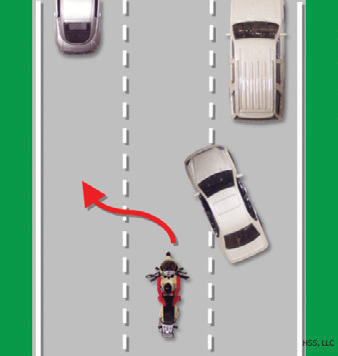
6.2 – Cornering
Many crash-involved riders enter turns too fast and are unable to complete the curve. The basic turning procedure – slow, look, press, roll – applies to all curves. Every curve is different. Be alert to whether a curve remains constant, gradually widens, gets tighter or involves multiple turns. Ride within your skill level and posted speed limits.
You should move to a position based on road condition and traffic before entering a curve and adjust as necessary. This permits you to spot approaching traffic as soon as possible. You can also adjust for traffic “crowding” the center line or debris blocking part of your lane.
Your best path may not always follow the curve of the road. Change lane position depending on traffic, road conditions and curve of the road.
- If no traffic is present, start at the outside of a curve to increase your line of sight.
- As you turn, move toward the inside of the curve, and as you pass the center, move to the outside to exit.
Widening Curves
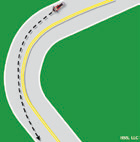
Constant Curves

Multiple Curves

Decreasing Curves (Tighter Turns)

Path Through a Curve

6.3 – Sharing the Road with Commercial Motor Vehicles
Commercial motor vehicles are vital to the economy of Georgia and the United States. Most of the products used in everyday life were delivered to stores by commercial motor vehicles. Drivers of commercial motor vehicles are trained, specially licensed driving professionals. Sharing the road with commercial motor vehicles is a necessary part of travel. Heavy trucks typically weigh 80,000 pounds or more, and riders should use caution when near them.
- A fully loaded tractor-trailer, traveling 55 mph, needs 3 times the distance a car needs to stop.
- Large trucks are more difficult to maneuver, are longer and heavier, and require more room to turn.
- Large trucks have larger blind spots, called “No-Zones.”
- Sharing the road safely includes not remaining in the blind spot of vehicles while passing them.

Typically, the larger the vehicle, the larger the blind spots. A commercial motor vehicle’s blind spots are dangerous because truck drivers can’t see vehicles in these areas.
It is impossible to completely avoid a truck’s blind spots. However, car drivers and motorcyclists should not remain in the “No Zone” any longer than needed to safely pass a heavy truck.
The easiest way to avoid lingering in the “No Zone” is to look for the truck driver’s reflection in the side mirror. If you cannot see the driver’s reflection, you are in the truck driver’s blind spot.
As depicted in this illustration, these areas around the truck include: directly in front, directly behind, and along each side of the vehicle - especially on the right side.
In this illustration the commercial motor vehicle’s blind spots, or “No Zones”, are highlighted in blue. These are areas to avoid whenever possible.
High Occupancy Vehicle (HOV) and High Occupancy Toll (HOT) Lanes
Motorcycles are permitted to use HOV lanes regardless of the number of persons riding on the motorcycle. Motorcycles may also use the HOT lanes at no cost by obtaining a toll-exempt PeachPass account. Contact the State Road and Tollway Authority at 1-855-PCHPASS (724-7277). However, motorcycles must pay regular tolls on designated toll roads.
Peach Pass

A PeachPass electronic toll transponder may be obtained to more easily pay for transit on designated toll roads; a PeachPass is required when using HOT lanes. To obtain more information about a Georgia PeachPass for all types of vehicles including motorcycles, go to: http://www.peachpass.com.
The Georgia Tact Project
Targeting Aggressive Cars & Trucks (And Motorcycles!)
Law Enforcement will stop people who drive unsafely around commercial motor vehicles, whether the person is driving a car, motorcycle or commercial motor vehicle.
What to do to avoid getting a citation:
- Don’t cut off commercial motor vehicles. For safety, one car length for every 10 miles per hour of speed is recommended.
- Don’t tailgate. Unlike cars, commercial motor vehicles have big blind spots behind them. Also, car drivers and motorcyclists who tailgate commercial motor vehicles can’t see traffic ahead. If the commercial vehicle brakes suddenly, you have no time to react and no place to go.
- Don’t speed. Speed is a factor in nearly one-third of all fatal crashes.
- Give all commercial motor vehicles plenty of room. Be careful when you or the commercial motor vehicle are entering a highway or merging with traffic.
Test Your Knowledge
- The best way to stop quickly is to:
- Use the front brake only.
- Use the rear brake first.
- Use both brakes at the same time.
- Where should you position your motorcycle when entering a curve:
- The outside of the curve.
- The inside of the curve.
- It depends on road condition and traffic.
Answers
- C – see the section "Stopping Quickly"
- C – see the section "Cornering"
Section 7: Special Riding Situations
This Section Covers
- Crowned Roads – 7.1
- Work Zones – 7.2
- Tire Failure – 7.3
- Animals – 7.4
- Wind – 7.5
The following section offers some additional information on special riding situations you may encounter when riding a motorcycle.
7.1 – Crowned Roads
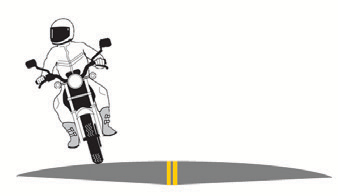
A road surface that is higher in the middle than at the sides is a crowned road. Use caution when going around curves to the left because ground clearance is reduced and the lean angle available will be less than on a flat road.
7.2 – Work Zones
Work zones present a hazard to all drivers but even more so for motorcycle riders. Lacking four-wheel stability, the motorcycle rider must reduce speed and be especially mindful of potential hazards.
The following are types of work zone road hazards and what to do if you encounter them:
- Sand or gravel on pavement – Slow down, don’t make sudden turns, brake lightly in a straight line. If you encounter long stretches of sand or gravel, downshift and keep your speed steady.
- Scored or grooved pavement – Keep your head and eyes up. Go slow, don’t fight the handlebars. Keep a steady throttle.
- Oil or fresh tar – Avoid if possible. Go slow and avoid sudden moves.
- Rippled and uneven temporary pavement – Scan the pavement and pick the smoothest line. Cross slowly and carefully. Be aware of the difference in height between lanes that have been repaved and those awaiting to be paved – crossing into the higher lane at high speeds and a narrow angle could cause you to lose control.
- Objects in the road – Scan well ahead. Go around object, if possible. Increase your following distance to allow maneuvering room.
7.3 – Tire Failure
You will seldom hear a tire go flat. If the motorcycle starts handling differently, it may be a tire failure. This can be dangerous. You must be able to tell from the way the motorcycle reacts. If one of your tires suddenly loses air, react quickly to keep your balance. Pull off and check the tires.
If the front tire goes flat, the steering will feel “heavy.” A front-wheel flat is particularly hazardous because it affects your steering. You have to steer well to keep your balance.
If the rear tire goes flat, the back of the motorcycle may jerk or sway from side to side.
If either tire goes flat while riding:
- Hold handgrips firmly, ease off the throttle, and keep a straight course.
- If braking is required, however, gradually apply the brake of the tire that isn’t flat, if you are sure which one it is.
- When the motorcycle slows, edge to the side of the road, squeeze the clutch and stop.
7.4 – Animals

Dogs sometimes chase motorcycles. Once an approaching dog is spotted, slow down and downshift until the dog is near your motorcycle, then accelerate crisply away from the dog as it approaches. Keep control of your motorcycle, and look to where you want to go. Don’t kick at the dog because it will make controlling the motorcycle difficult.
Larger animals such as deer or elk present a different problem. These animals are unpredictable, and hitting one can be as harmful as colliding with another vehicle. Use more aggressive SEE maneuvers for additional time and space in areas where larger animals may be present. If one of these animals is encountered on or near the roadway, the only reliable action is to stop before reaching it. Then wait until the animal leaves or move past the animal at walking speed.
7.5 – Wind
Strong, steady winds can affect you and your motorcycle. The effects can occur anywhere and often happen in open areas or mountainous terrain.
Wind turbulence can occur when you share the road with large vehicles like trucks, buses and recreational vehicles.
To respond to wind gusts or windblasts:
- Lean into the wind by applying forward pressure on the handgrip nearest the windblast.
- Move away from other vehicles as they approach or as you pass.
- Maximize the space cushion around you.
- Find a safe place to park until conditions improve if the wind becomes too dangerous.
Test Your Knowledge
- When riding over scored or grooved pavement in a work zone:
- Look down to see changes in the road surface.
- Keep your head and eyes up.
- Stay to the left side of the lane.
- If you are chased by a dog:
- Stop until the animal loses interest.
- Approach the animal slowly, then accelerate briskly away from the dog as it approaches.
- Swerve around the animal.
Answers
- B – see the section "Work Zones"
- B – see the section "Animals"
Section 8: Passengers, Cargo and Group Riding
This Section Covers
- Carrying Passengers and Cargo – 8.1
- Group Riding – 8.2
Only skilled, experienced riders should carry passengers or heavy loads or ride in groups. If you choose to carry passengers or heavy loads or ride in a group you will need to know some important information.
8.1 – Carrying Passengers and Cargo
Before carrying a passenger or heavy loads, know how both could affect motorcycle operation. The extra weight of a passenger or cargo will affect the way your motorcycle handles, requiring extra practice, preparation and caution. For this reason, only experienced riders should attempt to carry passengers or large loads. Before taking a passenger or heavy load on the street, check the air pressure of both tires and adjust the suspension settings to compensate for the lower rear of the motorcycle. Refer to the owner’s manual for more information.
When carrying a passenger, your motorcycle should have:
- A seat large enough to hold both of you. The passenger should be seated behind you and should sit as far forward as possible. No passenger regardless of age should be seated in front of you.
- Footrests for the passenger to prevent them from falling off and pulling you off, too.
- Secure hand strap or solid handholds for the passenger to hold onto. The passenger can also hold on to your waist, hips, or belt.
When riding with passengers:
- Ride a little slower, especially when taking curves, corners, or bumps.
- Start slowing earlier; you may need to use more pressure on the brakes.
- Wait for larger gaps to cross, enter, or merge in traffic.
- Incorporate a larger cushion of space when stopping or slowing the cycle.
Instructing Passengers
Your passenger should wear the same protective gear as you. As a routine practice, instruct your passenger on cycling basics prior to starting the trip. Even if your passenger is a motorcycle rider, provide complete instructions before you start.
Tell your passenger to:
- Get on the motorcycle only after you have started the engine.
- Keep both feet firmly planted on the cycle’s footrests, even when stopped.
- Keep legs away from the muffler(s), chains or moving parts.
- Hold firmly onto your waist, hips, or passenger handgrips.
- Stay directly behind you and look over your shoulder in the direction of the turn or curve to help you lean in the direction of the turn or curve.
- Avoid unnecessary conversation and movement when the cycle is in operation.
Also, tell your passenger to tighten his or her hold when you:
- Approach surface problems.
- Are about to start from a stop.
- Are about to turn sharply or make a sudden move.
8.2 – Group Riding
Riding with others is one of the many great experiences of motorcycling. Responsible riders do so in a manner that neither endangers nor interferes with the free flow of traffic. Riding with other cyclists may help to increase rider visibility and safety. Concentration and communication are essential to group riding. You should gain some riding experience before riding in a group. To enhance safety and reduce the risk of injury when riding in groups, you should:
- Plan ahead.
- Keep the group small.
- Keep a minimum two-second following distance.
- Ride in staggered formation – don’t pair up or ride beside one another.
- Move into single-file formation when riding curves, turns, or entering or leaving a highway.
- Group formation will change depending on the situation.
Staggered Formation

Passing in a Group
- Riders in a staggered formation should pass one at a time. If being passed while riding in a group, maintain your lane position.
- First, the lead rider should pull out and pass when it is safe. After passing, the leader should return to correct formation position to open up space for rider number two and ride at passing speed.
- After the first rider passes safely, the second rider should move from the right position to the left (lead) position and complete their pass, pulling into staggered formation behind the lead.
- The rest of the group follows this routine. Pass from the left position and return to the proper formation.
- The lead rider returns to cruising speed when the last rider has completed the pass.
Group Passing (Stage 1)
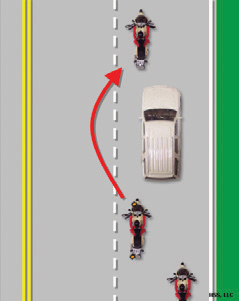
Group Passing (Stage 2)

Test Your Knowledge
- Passengers should:
- Look over the rider’s shoulder in the direction of the turn or curve.
- Never hold onto the rider.
- Sit as far back as possible.
- What formation should you form when riding in a group?
- Single-file formation.
- Depends on the situation.
- Staggered formation.
Answers
- A – see the section "Instructing Passengers"
- C – see the section "Group Riding"
Section 9: Factors Affecting Rider Performance
This Section Covers
- Cold Weather – 9.1
- Extreme Hot Weather – 9.2
- Night Riding – 9.3
- Distracted Riding – 9.4
- Fatigue – 9.5
Riding a motorcycle requires a great amount of mental alertness and physical skill. Sometimes changes in your environment occur, which can affect your visibility. Physical changes may occur as well, which may affect your riding performance. Responsible riders know how to adjust or compensate for factors which affect rider performance.
9.1 – Cold Weather
In cold weather riding, protect yourself by wearing proper protective gear like a windproof jacket and insulated layers of clothing. It is wise to dress in layers so the layers can be removed as desired. Topping the protective gear with a windproof outer layer can prevent cold air from reaching the skin.
Cold weather significantly lengthens your reaction time. To compensate for the slower reaction time, reduce your speed and increase your following distance and space to the sides.
Hypothermia
Riding for long periods in cold weather may lower your body temperature and cause hypothermia. Symptoms of hypothermia may include:
- Deterioration in physical coordination.
- Irrational, confused behavior.
- Sluggish movement.
- Shivering.
- Muscle tension.
- Shallow, slow breathing.
If chill is experienced, leave the roadway at your first opportunity and find shelter. Drink warm liquids, do some exercise to warm yourself, and if your clothes are wet, change out of them.
9.2 – Extreme Hot Weather
In extreme hot weather, wear protective gear that breathes. It is still important to wear a jacket and pants to protect you in a collision and to prevent dehydration. Drink plenty of water, stop and remove unnecessary, heavy clothing and dry your hands if they become slippery due to perspiration.
9.3 – Night Riding
Riding at night presents additional risks because a rider’s ability to see and be seen by others is limited. You should adjust your riding behavior to compensate for limited visibility by:
- Reducing Your Speed – Ride even slower than you would during the day, particularly on roads you don’t know well. This will increase your chances of avoiding a hazard.
- Increasing Distance – Distances are harder to judge at night than during the day. Open up a four second following distance or more. And allow more distance to pass and be passed.
- Using the Car Ahead – The headlights of the car ahead can give you a better view of the road than even your high beam can. Taillights bouncing up and down can alert you to bumps or rough pavement.
- Using Your High Beam – Get all the light you can. Use your high beam in clear weather whenever you are not following or meeting a car.
- Be Visible – Wear reflective materials when riding at night.
- Being Flexible About Lane Position – Change to whatever portion of the lane is best able to help you see, be seen, and keep an adequate space cushion.
9.4 – Distracted Riding
A distraction is anything that takes your attention away from riding. Rider distractions may occur anytime and anywhere. Distracted riding can cause collisions, resulting in injury, death or property damage. Taking your eyes off the road or hands off the motorcycle presents obvious riding risks. Mental activities that take your mind away from riding are just as dangerous. You must constantly maintain your full attention to the riding task. You are completely and solely responsible for operating your motorcycle in a safe manner.
9.5 – Fatigue
Fatigue can affect your control of the motorcycle. To minimize the potential for fatigue:
- Get a good night’s rest – A good night’s rest is important for preventing fatigue.
- Protect yourself from the elements – Wind, cold and rain make you tire quickly. Dress warmly. A windshield is worth its cost if you plan to ride long distances.
- Vary speed and position on seat regularly –The stimulation resulting from slight changes in speed or in body position will help to overcome the effects of fatigue.
- Take frequent rest breaks – Stop and get off the motorcycle every two hours or as needed.
- Don’t use artificial stimulants – Artificial stimulants often result in extreme fatigue or depression when they start to wear off. Riders are unable to concentrate on the task at hand.
Test Your Knowledge
- When riding at night:
- Use the left portion of the lane to see around other vehicles ahead.
- Ride close to the vehicle in front of you to see better with their headlights.
- Reduce your speed to increase your chance of avoiding a hazard.
- To minimize the potential for fatigue:
- Turn on the radio and open the window.
- Take frequent rest breaks.
- Drink caffeine.
Answers
- C – see the section "Night Riding"
- B – see the section "Fatigue"
Section 10: Three-Wheeled Vehicles
This Section Covers
- Types of Three-Wheel Vehicles – 10.1
- Autocycles – 10.2
- Differences Between Two-Wheel Motorcycles and Three-Wheel Vehicles – 10.3
- Be Familiar with Your Vehicle – 10.4
- Body Position – 10.5
- Turning – 10.6
- Hills – 10.7
- Lane Position – 10.8
- Parking at the Roadside – 10.9
- Swerving – 10.10
- Cornering and Curves – 10.11
10.1 – Types of Three-Wheel Vehicles
Traditional two-wheel motorcycles are considered single-track vehicles. Three-wheel vehicles could have either double or triple tracks. Double track vehicles are motorcycles with sidecars, while triple track vehicles (trikes) can have either two front wheels or two rear wheels.

10.2 – Autocycles
The Georgia General Assembly changed the definition of a Class C motor vehicle in O.C.G.A. § 40-5-23(c) to include three-wheel motor vehicles equipped with a steering wheel. They also changed O.C.G.A. § 40-6-311(b) to distinguish motorcycles as motor vehicles controlled by handlebars requiring the operator to straddle the seat.
10.3 – Differences between Two-Wheel Motorcycles and Three-Wheel Vehicles
A three-wheel vehicle is naturally more stable than a two-wheel motorcycle. However, under certain conditions it could “tip over” or lift one of the wheels off the pavement. In order to ensure its stability, you will need to pay attention to your body position, your speed, and how you load a three-wheel vehicle.
They also steer differently. Since three-wheel vehicles cannot lean, the front wheel needs to be pointed in the direction you want the vehicle to go.

10.4 – Be Familiar with Your Vehicle
Make sure you are completely familiar with the three-wheel vehicle before you take it out on the street. Be sure to review the owner’s manual. Remember, three-wheel vehicles take up more space than two-wheel motorcycles and therefore you will need more space to maneuver.
10.5 – Body Position
Your body position is important for control on a three-wheel vehicle. You should be able to reach both handgrips comfortably while leaning and shifting your weight in turns.
10.6 – Turning
Approach turns and curves with caution. If you enter a turn too fast you may end up crossing into another lane of traffic, lifting a wheel, or going off the road. Oversteering could cause the vehicle to skid and you could lose control.
10.7 – Hills
When riding uphill on a three-wheel vehicle, some weight will shift to the rear, causing the front of the vehicle to become lighter. This weight shift reduces the traction on the front wheel(s) for steering and braking. You should shift some of your body weight forward to maintain steering control.
When riding downhill, gravity increases the amount of braking force required to slow or stop the vehicle. It is important, therefore, to begin slowing earlier for cornering and stopping.
10.8 – Lane Position

The width of a three-wheel vehicle is similar to the width of some automobiles, therefore, unlike a two-wheel motorcycle, you are limited in lane positioning. Keep toward the center of the lane and within the lane markings.
Lane positioning when riding in groups is also an important consideration. Ride single file and always maintain a safe margin, four seconds minimum, between vehicles.
10.9 – Parking at the Roadside

Position your vehicle in a parking space so you are parked parallel to the curb. Set the parking brake or leave it in gear to keep it from rolling. Parking parallel to the curb will facilitate pulling away from the curb and entering the lanes of traffic.
10.10 – Swerving
A three-wheel vehicle is not as maneuverable as a two-wheel motorcycle, so it is important to look well ahead to avoid the need for any sudden turns or swerving. Swerving is seldom the best option to avoid a collision on a 3-wheel vehicle. If swerving is required, brake either before or after the swerve, never while swerving. You should not attempt swerving without proper training. If you need to avoid a collision, the best option may be hard braking.
Brake, then Swerve

Swerve, then Brake

10.11 – Cornering and Curves
When riding through curves, remember to stay within your lane.
Adjust your speed before entering a curve. You may need to lean or shift your weight in the direction of the turn to avoid causing any of the wheels to leave the ground and, possibly, losing control.
Test Your Knowledge
- What are two major differences between two-wheel motorcycles and three-wheel vehicles? A three-wheel vehicle:
- Is less stable, and is steered by pointing the front-wheel in the direction of the turn.
- Is more stable, but could tip-over and is steered by pointing the front-wheel in the direction of the turn.
- Is more stable, but could tip-over and is steered by pointing the front-wheel in the opposite direction of the turn.
- When riding a three-wheel vehicle in groups, you should:
- Ride single file and maintain a four-second following distance.
- Ride in staggered formation and maintain a four-second following distance.
- Ride single file and maintain a one-second following distance.
- When parking a three-wheel vehicle, you should park:
- At a 90-degree angle to the curb.
- On the sidewalk.
- Parallel to the curb.
- What is true of swerving on a three-wheel vehicle?
- Swerving is the best option to avoid a collision.
- When swerving, you should brake and swerve at the same time.
- It should not be attempted without proper training.
Answers
- B – see the section "Differences between Two-Wheel Motorcycles and Three-Wheel Vehicles"
- A – see the section "Lane Position"
- C – see the section "Parking at the Roadside"
- C – see the section "Swerving"
Section 11: Trikes
This Section Covers
- Turning – 11.1
- Stopping Quickly – 11.2
- Carrying a Passenger and Cargo – 11.3
11.1 – Turning

Because the weight of a trike is distributed almost equally between the two front or two rear wheels, these vehicles handle the same in left and right turns. When turning a trike:
- Approach a turn with your head up, and look through the turn.
- Adjust speed before the turn to allow you to safely accelerate through the turn.
- Lean or shift your weight in the direction of the turn.
- Steer the front wheel(s) toward the turn.
- Accelerate gradually as you exit the turn.
11.2 – Stopping Quickly
An important handling characteristic to be aware of on a standard trike (1 wheel up front, 2 in the rear) is that the two rear wheels have more braking power. How much varies by trike design. This is because weight does not shift to the front wheel on a trike during hard braking. Most of the weight stays on the rear wheels and makes the rear brakes more effective.
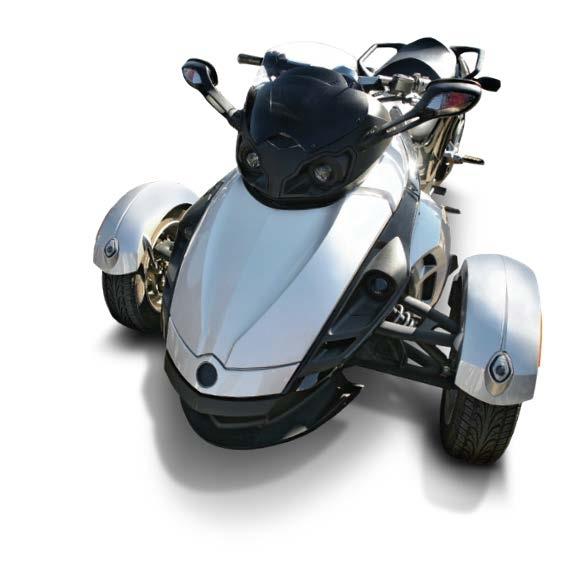
11.3 – Carrying a Passenger and Cargo
Only skilled, experienced riders should carry passengers or heavy loads. The additional weight of a passenger or cargo will change the handling characteristics of the vehicle.
If a passenger is being carried, the passenger will sit directly behind you. When carrying cargo, center the load and keep it low in the storage areas so it is balanced side-to-side. Refer to your owner’s manual for more information.
Test Your Knowledge
- When turning a trike, how should you approach the turn?
- With your head up and adjusting your speed before the turn.
- With your head down and accelerating.
- With your head down and adjusting your speed.
- Where should you place a load on a trike?
- Place the load towards the right of the motorcycle and keep it high in the storage area.
- Place the load towards the center of the motorcycle and keep it low in the storage area.
- Place the load in front of the motorcycle and keep it high in the storage area.
Answers
- A – see the section "Turning"
- B – see the section "Carrying a Passenger and Cargo"
Section 12: Motorcycles with a Sidecar
This Section Covers
- Stopping – 12.1
- Accelerating – 12.2
- Turning – 12.3
- Stopping Quickly – 12.4
- Carrying Passengers and Cargo – 12.5
12.1 – Stopping

Check your sidecar for brakes. Some sidecars are equipped with brakes while others are not. Your stopping distance and handling will be affected if your sidecar is not equipped with brakes.
You may need to steer slightly in the direction of the sidecar when applying the motorcycle brakes if your sidecar is not equipped with brakes.
12.2 – Accelerating

During acceleration, steer slightly in the opposite direction from the sidecar to maintain a straight line path.
12.3 – Turning
When operating a sidecar-equipped motorcycle, additional consideration needs to be given to the direction of the turn and amount of weight in the sidecar. When turning a motorcycle with a sidecar:
- Evaluate the degree of turn required.
- Adjust speed before the turn to allow you to safely accelerate through the turn.
- Lean or shift your weight in the direction of the turn.
- Maintain speed as you enter the turn.
- Accelerate gradually as you exit the turn.
Turning Left

During a left turn, the sidecar acts as a stabilizer, so the sidecar wheel stays on the ground. However, if the turn is taken too sharply or at too great a speed, it may cause the rear wheel of the motorcycle to lift off the ground and the nose of the sidecar to contact the pavement.
Turning Right

A right turn taken too sharp or at too great a speed may cause the sidecar wheel to lift off the ground. The lift will be greater if the sidecar is empty or lightly loaded. You can avoid this wheel lift by slowing before entering the turn and shifting more of your weight to the inside of the turn, towards the sidecar.
12.4 – Stopping Quickly
Stopping quickly in a straight line is the primary technique for avoiding collisions in traffic. Always, use the front and rear brakes simultaneously, adjusting pressure on the levers to apply maximum braking just short of skidding either wheel. If the front wheel skids, ease off some of the pressure to regain steering control. If the rear wheel skids, keep it locked until the vehicle has stopped completely. If the sidecar wheel has a brake, and that wheel starts to skid, you can safely ignore it.
Making quick stops in a curve is more difficult, especially if the road curves to the right. Hard braking in a curve to the right tends to lift the sidecar, which may require additional weight shift to the right to compensate. Stopping quickly in turns to the left is less dangerous because there is a reduced danger of tipping over. And, if the wheels skid, the vehicle will slide toward the road shoulder, not into the opposing lane of traffic.
12.5 – Carrying Passengers and Cargo
Only skilled, experienced riders should carry passengers or heavy loads. The additional weight of a passenger or cargo will change the handling characteristics of the vehicle.
You must give some thought to where the passengers are seated and the loads are positioned. The best place for a passenger is in the sidecar. Avoid carrying a passenger behind you while leaving the sidecar empty. This could increase your chances for a tip over. If you have two passengers, place the heavier passenger in the sidecar to improve handling. The passenger sitting behind you should sit upright at all times. It is not necessary for the passenger to lean into curves with you. When loaded, your vehicle will need more time and distance to stop. You will need to increase your following distance.
When carrying cargo in a sidecar, it should be centered low, over the sidecar axle and secured firmly in place. If the cargo shifts, handling will be affected.
Test Your Knowledge
- When stopping a motorcycle with a sidecar:
- Steer straight ahead.
- Steer slightly in the direction of the sidecar.
- Steer slightly in the opposite direction of the sidecar.
- When accelerating on a motorcycle with a sidecar:
- Steer straight ahead.
- Steer slightly in the direction of the sidecar.
- Steer slightly in the opposite direction of the sidecar.
- How can you avoid the sidecar wheel lifting off the ground in turns?
- Accelerating before the turn and shifting your weight towards the sidecar.
- Slowing before the turn and shifting your weight towards the sidecar.
- Slowing before the turn and shifting your weight opposite of the sidecar.
- When stopping quickly and the front wheel skids, you should:
- Keep it locked until the vehicle has completely stopped.
- Ease off some of the pressure to regain steering control.
- Hold the handgrips firmly and ease off the throttle.
- Where is the best place for a passenger on a motorcycle with a sidecar?
- In the sidecar.
- Behind the rider.
- In front of the rider.
Answers
- B – see the section "Stopping"
- C – see the section "Accelerating"
- B – see the section "Turning"
- B – see the section "Stopping Quickly"
- A – see the section "Carrying Passengers and Cargo"
Danger: All DMVs are not Alike!!!
Beware of fake DMV websites that charge for training materials or informational material. Most customers arrive at these sites by doing a browser search for "Georgia DMV," "Georgia License Renewal" or similar generic searches.
Please read the pages of these sites carefully, because by law they are required to inform users that the site is not affiliated with any State or Government Entity. They are privately owned sites that will have .com or .org at the end of their website address (url). The official state of Georgia websites will have .gov as is the case with www.dds.georgia.gov.